Welcome to Bimini Bay Sailing Lessons
Small sailboat sailing school.
I sold my last sailboat in July, 2023. I will still give occasional lessons for individuals who own their own small powerboat or sailboat.
Have a new Keelboat or Powerboat? I give small keelboat and small motorboat lessons on your boat, covering such topics as docking, backing up, pivot turns, and more as I share local knowledge of our waterways...
Bimini Bay is a beautiful, sheltered body of water nestled inside Anna Maria Island. It is the perfect, safe place to learn to sail -- and we often see dolphins! Bimini Bay Sailing is just minutes from Holmes Beach, Longboat Key, and Bradenton, snuggled between Tampa Bay and the Gulf of Mexico. During the last part of your saling lesson we usually sail just off the shore of Anna Maria Island into Tampa Bay, with a clear view of the Sunshine Skyway, Egmont Key and the Anna Maria Pier.

Take Sailing Lessons on the very stable WindRider 17 Trimaran, with a quiet electric motor for uncertain breezes. Or at your location on your own small dinghy sailboat or keelboat. I also offer powerboat docking lessons on your own boat.
Learn how to use a mainsheet, jib sheets, and a furling line. learn how to tack, jibe, and how to rig a sailboat. learn your basic points of sail. students usually sail at least half of the time on their own..
If you already know how to sail and you want to rent a Trimaran, for your safety and pleasure, I will still do a skills and safety review. Then I'll go out with you as your coach/guide, on the same sailboat, but you will do almost all of the sailing. This is to make your experience as safe and pleasant as possible.
Captain Floyd Jay Winters , an instructor for Bimini Bay Sailing since 2012, has taken over the helm of the Anna Maria Island small sailing school. (He is fully vaccinated.) To schedule a sailing lesson, you can reach Coach Jay Winters at 941.730.2719 or click on the [ Contact ] link.
I encourage a follow up session to refine your skills and have to opportunity to get more sailing time on your own. Parents or spouses are welcome to watch the sailing class and take photos of their kids or spouse as they learn to sail. Click the [ Lessons ] link for more information on what is covered.
Click the [ Photos ] link to see beautiful photos of Sunfish at Bimini Bay Sailing School.
A Father and Son Tacking a Sunfish (29 seconds)
For the past 11 years, Bimini Bay Sailing has offered a sailing summer camp through the Anna Maria Island Community Center. And once again this past June 2022, fourteen young sailors had the opportunity to safely experience the excitement of their first exposure to sailing during our mini sailing camps at Bimini Bay.
Receive sailing lessons at our small sailing school or just refresh your sailing skills in beautiful Bimini Bay. The magical waters around Anna Maria Island are warm, clear, and uncrowded.
Arial Map 1 Arial Map 2
Bimini Bay Sailing, Anna Maria Island , Florida
Skipper Small Sailboat | Online Sailing Course
Learn to sail small keelboats.
This interactive online course equips beginner to intermediate sailors with the knowledge and theory to confidently handle 18 to 25ft keelboats in moderate conditions. Covering topics from outboard engine operation to sail trim and leadership, you'll learn to sail, maneuver, and dock your boat confidently. Recognized by the US Coast Guard as meeting the American National Standards for sailing training – theory portion.
Estimated Time: 10 - 15 hours Price: $45 $39
Enroll in this course to learn how to sail small sailboats (keelboats) up to 25ft. This comprehensive Skipper Small Sailboat online sailing course is designed to teach you all the theory, knowledge, and strategies necessary to safely and competently sail small sailboats (keelboats). Optional practical training is available through our international instructor network. If you are a beginner sailor, or new to small keelboats, then simply you should learn the theory and knowledge to sail small keelboats; including sail trim, basic navigation, electronics, outboard motor operation, docking, and emergency procedures.
Whether you are a beginner or intermediate sailor, you will gain the skills and knowledge necessary to confidently handle a small keelboat in moderate conditions. By the end of the course, you will be able to confidently navigate inshore, maneuver, and dock your boat, as well as respond to any emergencies that may arise.
This course is recognized by the US Coast Guard as meeting the American National Standards for sailing training - theory portion.
Topics covered in the Skipper Small Sailboat (Keelboat) Course
- Weather and Sea Conditions
- Electrical and Mechanical Systems
- Rules of the Nautical Road
- Maneuvering in the Marina
- Communications
- Navigation Introduction
- Anchoring and Mooring
- Coping with Emergencies
We guarantee both your satisfaction AND Lifetime access to any sailing course you buy from us!
This course, when combined with practical on-the-water training and assessment at any of our qualified NauticEd schools, is officially approved as meeting the On-Water Recreational Boating Skills Standard - SAIL developed by the United States Coast Guard. It is the only course in the world approved to this high standard.
The NauticEd Skipper Small Keelboat course is for those wishing to successfully master the skills needed to sail a boat in the 18 to 25-foot range. The course covers everything from the outboard engine and maneuvering skills to sail trim and understanding how to be a true leader on a small keelboat.
More about the Skipper Small Sailboat Online Course
- Available immediately online and offline on our iOS App
- Extensive and essential knowledge for sailing at the beginner / intermediate levels
- This Sailing Course takes approximately 10-15 hours of total time to complete
- Take as long as you need to complete
- Return as many times as you like to review
- You may take the tests anytime and as many times as you like online via browser or offline via our iPad/iPhone testing app. See our sailing apps page
- Adds the Skipper Small Keelboat course endorsement to your Sailing Resume
- Optional Practical Training available through our international network of instructors
- Learn to sail small sailboats with this comprehensive online sailing course.
- View Skipper Course excerpts
Upon completion of the online course, you will feel confident that you know the theory of what to do when in command of a sailboat. And if you're new to the fun of sailing, you'll look like a pro in front of your hands-on instructor. Upon successful completion of the associated practical training with a NauticEd American National Standards Instructor, and subsequent logging of two days of training in your free electronic logbook you will receive a sailing certificate displaying the United States Coast Guard VERIFIED COURSE badge.
Are you ready to "get your feet wet" and feel the exhilaration of sailing? Then let's get started!
The test is reasonably simple as long as you have read the material. You can take the test as many times as you like to pass or improve your score without any extra cost. Once passed, the NauticEd Skipper Small Sailboat course will be added to your online sailing resume. And the great thing, once you've registered, you can log back in for life for FREE to review the material and brush up your skills. We're constantly updating the course and adding information on new technologies as they emerge, so for just $39 - you'll always be up to date.
If you still have questions about NauticEd, the courses, and/or the sailing certifications, just contact us via email or phone we're happy to help. Otherwise, register for the Skipper Course now!
Learn all the theory of sailing in the comfort of your home at your own pace with NauticEd. Register for the Skipper Course now!
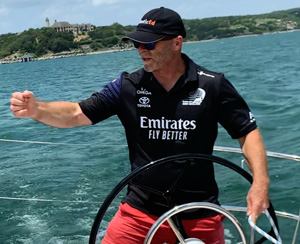
View Skipper Small Keelboat Course excerpt
Student Reviews
Great 2nd step up from basic and/or dinghy sailing course, preparing a student for a day or weekend on a small keelboat
its delivery method is simple and easy to understand
Did this after passing for Captain so it was good repetition :-)
A great course layout with the ability to be flexible and base your learning around your life. You can also go back and repeat it as often as you'd like to refresh your knowledge.
Was a while ago, but all of these courses were challenging to me and I appreciate that
I love the intuitive way the courses have been created. The fact that the material is available to view again later is very useful as a refresher when it's been a while since the course was taken. The explanations on the test as to why you got an answer wrong is very helpful in correcting your understandings.
Great course on sailing small keelboats!
Online, good user interface, knowledgeable course writers, humor. Thank you!
comprehensive and helpful
EVERYTHING! I have been wanting to learn how to sail for what seems like my whole life. The best part of the course was on the final day, without a doubt, I had the feeling of "yea I am, and can safely skipper a small keelboat" this feeling and I can't stress this enough, was a big part of how our instructor handled the class and the depth at which she gave us (Instructor: Maureen Vild)
The instructor was the best part of the course. Hands down Maureen made this experience enjoyable on the water. Nothing beats the sound of turning off the motor and being under sail power. With Maureen, every opportunity was a learning lesson from the chats at lunch to when you asked a question she would let you talk it out and guide you through to the best answer. I will be taking the Large Skipper Keelboat course with Santana Sailing and Maureen.
Excerpt from the course
Apparent wind.
Apparent wind is the result of the true wind and your boat speed. Here is an explanation that you easily grasp because it relates to something you experience almost every warm summer's day.
Play with this animation by sliding the slider to speed up the car. Then read the below text and replay this animation.
NOTE: This is best viewed in Firefox, Chrome, or Safari
Put your hand outside the window of your car traveling at 60 miles per hour on a still-warm summer day and your hand will feel a 60-mile-per-hour wind coming from the front of the car. That’s apparent wind yet the true wind is zero. What if the car was driving into a 20-mile-per-hour headwind? Your hand would feel 80 mph. Or if the wind was blowing from behind at 20 mph, your hand would feel 40mph.
Now, what about a crosswind of 20 miles per hour? Well, we need to do a little Pythagorean theorem work on this. What is the square root of the sum of 60 squared plus 20 squared? Your hand would feel 63.24 mph and mostly from a direction in front of the car. If the car accelerated to 100 mph your hand would feel 102 mph, again mostly from the front. If the car decelerates to 10 mph your hand would feel 22 mph mostly from the side of the car and if the car stopped you’d feel the full true wind of 20 miles per hour from the side of the car. Whatever your hand feels is the apparent wind. The apparent wind equals the true wind when your car is not moving.
When determining the direction of the apparent wind, the faster the car goes the more the apparent wind direction comes from the direction of travel of the car. Again imagine the crosswind. At 1 mph forward speed in your car and a 20 mph crosswind, the apparent wind feels almost like the true wind from across the car. As the car accelerates the wind feels more and more like it is coming from the front.
This is similar to a boat. The faster the boat sails into the wind, the more the apparent wind speed increases and the more it feels like it is coming from the front of the boat.
So now that you understand the difference – let’s put the practical application to work for you on a sailboat.
Sea talk testimonials
I really appreciate your website and services. Living on the East Coast the winter gets really looooong. Having a site like yours to work on is a great way to stay tuned into sailing and to improve your skills. John R , Student
Trusted by the world's leading sailing companies
How nauticed works.
- Sailing Courses
- SLC - Sailing License
- Sailing Vacations
- Sailing Schools
- Practical Courses
- Boating Knowledge Base
- Fighting Childhood Cancer
- Free Courses Signup
- Gift a Sailing Course
- Sailing Opportunities
- Sailing Licenses and Certifications
- About the Sailing Certifications
- Sailing Blog & Helpful Articles
- NauticEd Podcast Series
- Yacht Charter Resources
- School Signup
- Instructor Signup
- Affiliate Signup
- Boat Sharing Software
- Sailing Industry Services
- Support & Contact
- Privacy Policy

Home Education
Learn to Sail with US Sailing
Whether you’re a first time sailor or an experienced instructor... we have an educational opportunity for everyone...
Part of US Sailing’s vision is to introduce as many people as possible to this great sport. We want to make sure you’re learning in a safe, fun, high-quality environment…because if you’re a well-trained, competent sailor you’ll love sailing as much as we do.
US Sailing provides education and instruction in four separate areas: Small Boat (i.e. day sailing), Keelboat, Powerboat and Windsurfing. Learn more about the different programs offered by US Sailing schools and instructors. We’ll help you decide what kind of boat you want to learn on and find a course to take – and we’ve written the books ourselves to make sure they’re the best around.
Youth Education
Quality instruction at all levels.
US Sailing is committed to ensuring that young people learn how to sail from certified instructors in a safe and fun environment. We have set the standard for youth sailing programs in the U.S. by offering certification courses for instructors and coaches, as well as the innovative Reach STEM education program.
Learn More about Instructor Certifications
- Learn to Sail
- Reach Program - STEM Education
- Junior Big Boat Program Guide
- Youth Development
- US Sailing & SafeSport
Adult Education
Build your skills.
The Keelboat Certification System offers seven levels of adult education ranging from Basic Keelboat through Offshore Passagemaking. These certifications follow a building-block technique of combining learned skills with experience. New sailors gain knowledge and experience at each level and can take their sailing skills as far as they want to go at their own pace
Find a Course Near You
- Certification Courses & Endorsements
- Safety at Sea Courses
- Adaptive Sailing
- Adaptive Sailing Resource Manual
Instructor Training & Certification
Teach others to sail.
For those interested in teaching sailing or powerboating, there are several opportunities to achieve Instructor Certification. We offer certification for smallboat, keelboat, powerboat, windsurfing and STEM instructors. Courses range from 2 days to 5 days, and are hosted by boating programs around the country, year-round.
See All Instructor programs
- Small Boat Instructor Programs
- Keelboat Instructor Programs
- Powerboat Instructor Programs
- Teach Windsurfing
Race Officials Training & Certification
Represent us sailing on the race course.
Race officials ensure quality, integrity, and consistency for all participants in the sport of sailboat racing, from casual weeknight club racing to world championships. Our training and certification programs allows sailors to give back to the sport by supporting the racing sailor out on the water.
See All RO programs
- Find a Seminar
- Host a Seminar
- Race Officials & SafeSport
Risk Strategies - Gowrie Group
- Junior Sailing Safety Guide

Andrew Clouston SVP Programs & Services Email Andrew Clouston

Stu Gilfillen Director of Education Email Stu Gilfillen 401-342-7967

Peri Burns Educational Operations Manager Email Peri Burns 401-342-7963

Bradley Schoch Senior Instructional Designer Email Bradley Schoch

Andi Barton Sr. Education Coordinator Email Andi Barton 401-342-7910

Bonnie Braddock Learning Design and Development Specialist Email Bonnie Braddock
Copyright ©2018-2024 United States Sailing Association. All rights reserved. US Sailing is a 501(c)3 organization. Website designed & developed by Design Principles, Inc. -->
How To Learn To Sail: Ultimate Step-By-Step Guide
Getting into sailing can seem daunting. When I first got interested, I was completely overwhelmed by all the skills, conflicting information, - and man oh man - all those insider terms. If you don't know where to start, it can be very confusing.
How to learn to sail? When first starting out, you want to gain some experience on the water, learn basic sail trim and navigation, and learn the basic safety rules. You can learn this by taking online courses, and by taking sailing lessons. With the right approach, you could get up to speed in a couple of months and for as little as $500.
Learning from my own experience, I wanted to create a very easy-to-understand guide which walks you through everything you'll need to know and learn when first starting out. In this guide, I'll walk you through all the different aspects of sailing: what to expect (ie. costs), what skills you'll need and how to learn those, and what knowledge you'll need and where to find it.
Spoiler : it's cheaper and easier to learn than you would expect.
Over the last few years, I have written on a lot of different aspects of getting into sailing. Throughout this guide, I will regularly refer to specific articles where you can learn more on a specific topic. This guide is a jumping-off point you can use to quickly get up to speed, and dive in deeper on a particular topic whenever you feel like it.
As a result, it is a long article with lots of information; it may be too much to read all in one sitting. The upside is: it's all here. I recommend bookmarking this article and coming back to it every now and then and pick up where you've left. Let's get started.
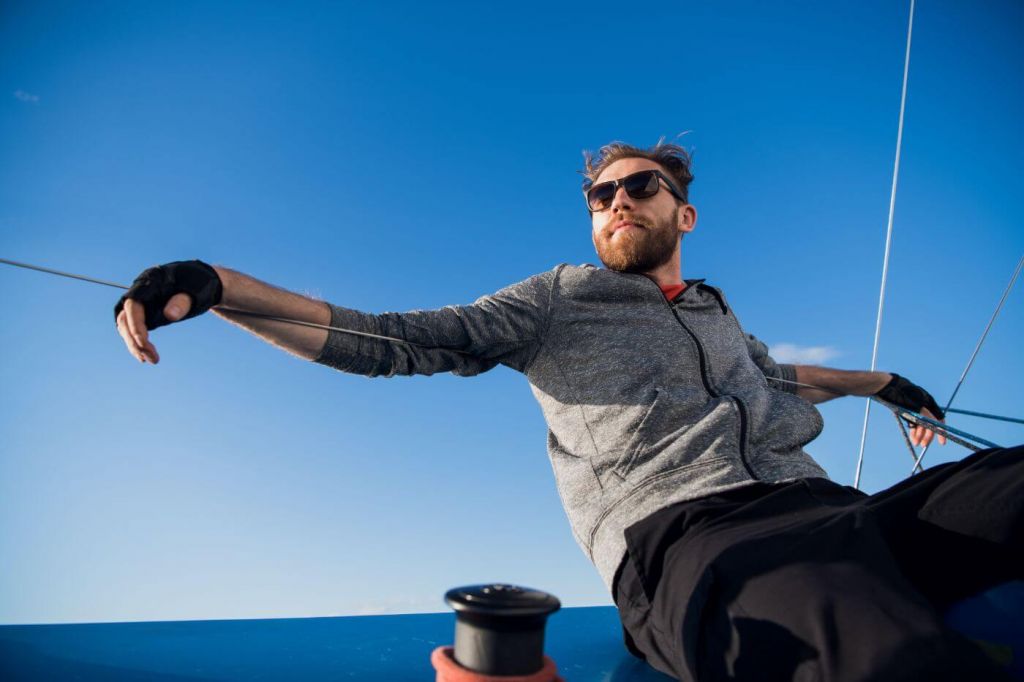
On this page:
How to get into sailing, myths that could be holding you back, how to get started, skills you need to learn to sail, things you'll need, in conclusion.
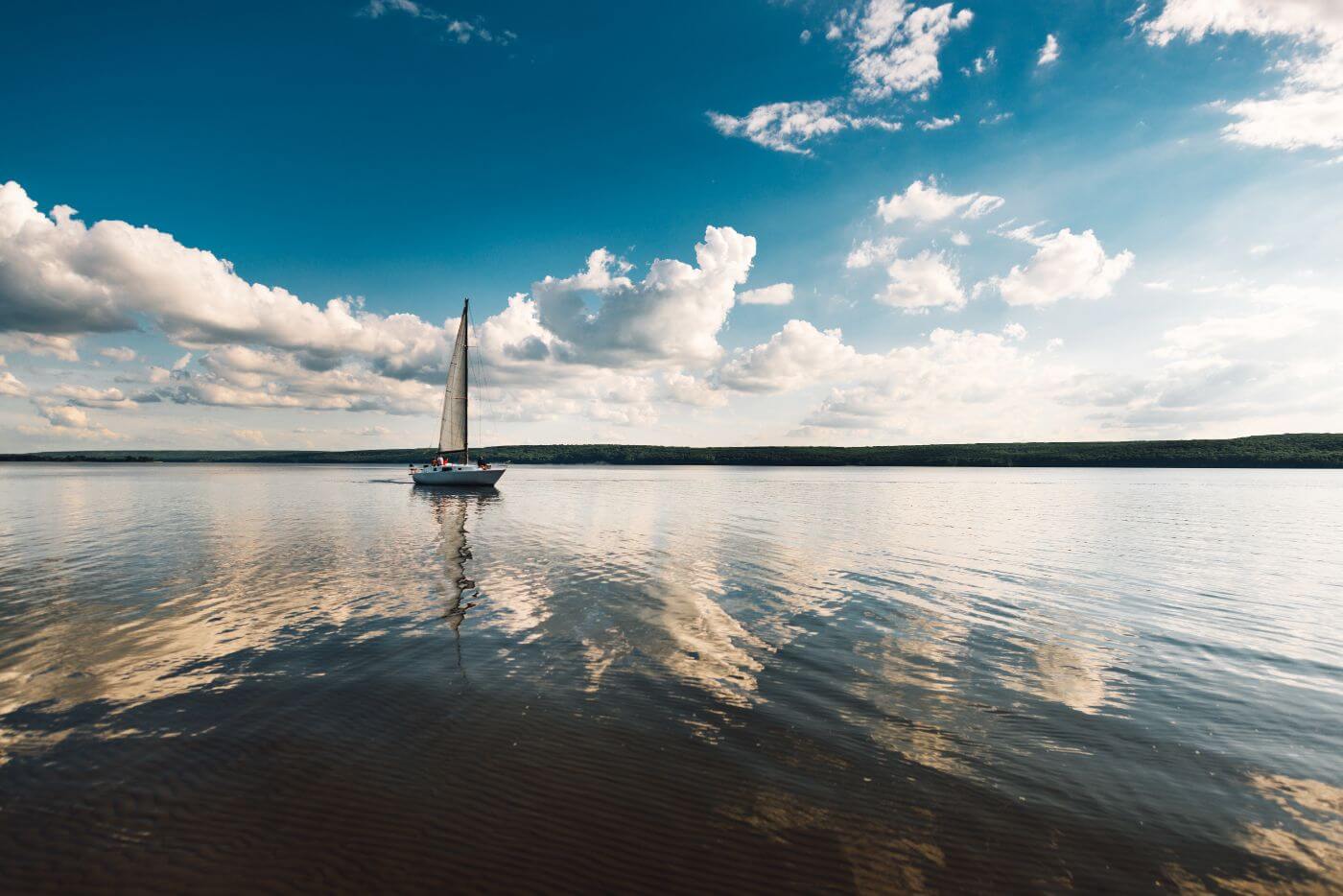
Sailing is both a practical and theoretical skill. You really should gain real-life experience, but you can also learn a lot of essential skills by reading up on them. Let me quickly walk you through my recommendation of how to getting into sailing.
7 easy steps to get into sailing:
- Focus on learning the theory first, focus on practice second
- The essential sailing skills are sail trim, navigation, and boat safety
- Start out using (free) online resources or Sailaway simulator
- After that, gain experience by taking at least a couple of sailing lessons
- To cut cost, you could also crew for an experienced captain instead
- Get your boater's license if necessary
- Hire a boat at first to cut cost and figure out what you like
By first focusing on the theory, which you can mostly do using free resources (and this website), you save on those valuable sailing lessons.
I'll break down all of these steps later. But now, we first have to talk about some common misconceptions about sailing, what it costs, and how long it takes before you sail your first boat by yourself. It's sooner than you might think.

Sailing is known to be an elite sport that costs way too much money. It's hard to learn, expensive to do, and you need all kinds of special knowledge - right? Well, all of those things can absolutely be true, if you want them to be. But sailing has always been one of the cheapest ways of transportation and can be quite easy to learn. I had a ton of those common misconceptions myself, and they were keeping me back. Maybe some of those are holding you back too?
Let me tell you some secrets that will probably change the way you think about the timeline of your sailing dream.
Sailing can be an affordable hobby
- A realistic budget for beginner sailors is $100 - $300 per month
- If you want to, you can get a decent education for as little as $500
- A decent beginner sailboat can cost between $200 - $2,000
In order to sail, you need some things that potentially cost a lot of money:
- a sailboat (preferably a 52' superyacht, right?)
- sailing lessons (and probably tons of them, right?)
- speciality gear like navigation equipment (you can't use regular water bottles, right?)
I say potentially because it really doesn't have to be that way. Sailing can be a normal hobby for regular people that have normal budgets.
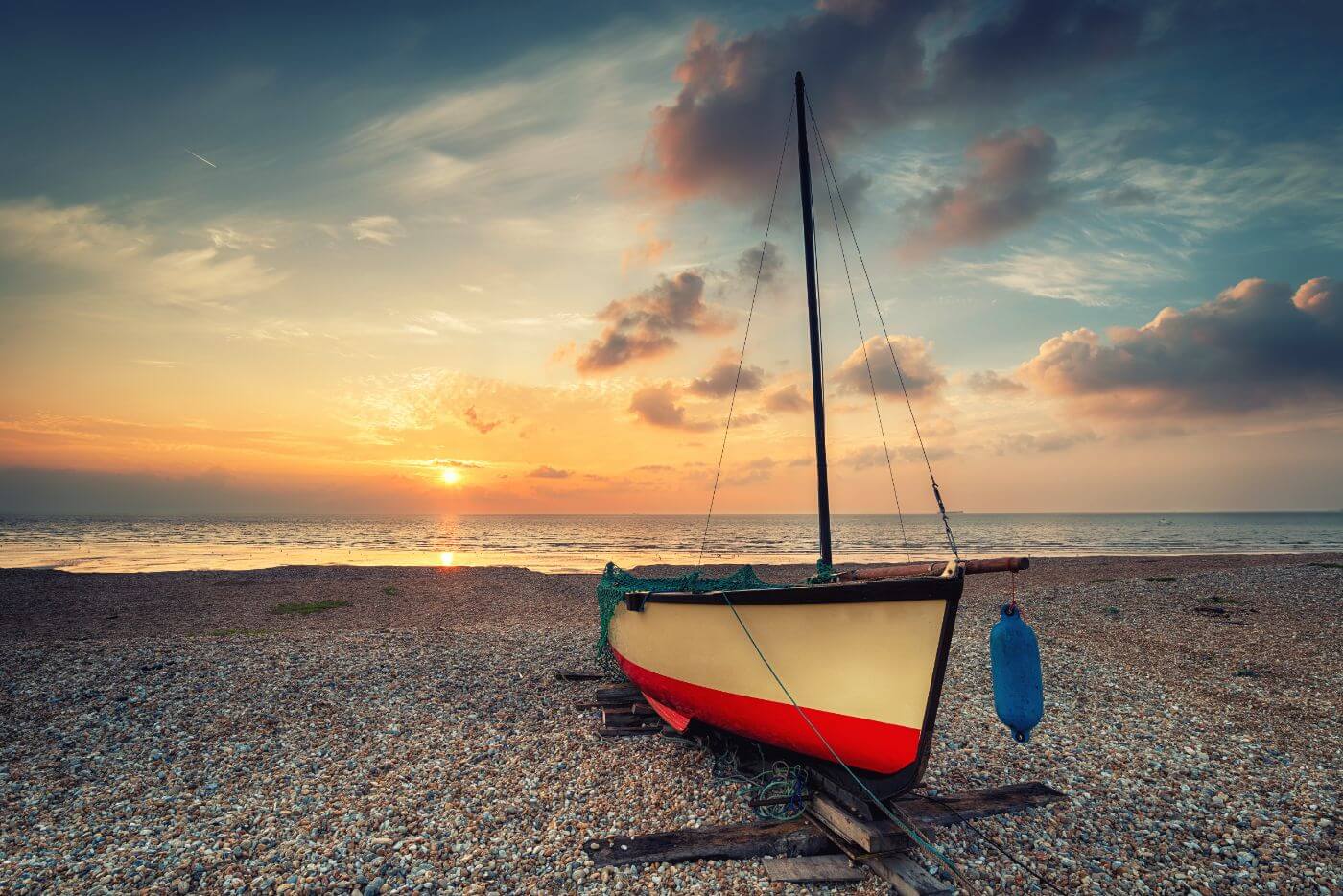
Sure, you can spend tons of money on gear and lessons, as with any hobby. You can get yourself special sailing water bottles that provide more optimal water disposal flow in marine environments. You can buy a world-cruising yacht. But let's be fair: you don't own a plane (if you do, call me), yet you are able to fly to nearly every place on Earth if you want to. If you prioritize, you actually don't need all that much gear ór lessons.
In most states and countries, you actually don't even need an official education in order to sail smaller boats. I do recommend getting some training in advance. But you can really get a super decent training and tons of experience on just a $500 budget .
Want to get into sailing on a budget? I've written a detailed guide on how to learn the most important sailing skills on less than $500 . There are tips in there that cost absolutely nothing and are very good first steps.
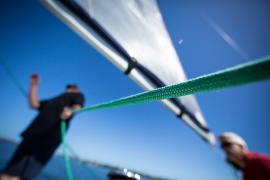
9 Ways to Learn to Sail for (Practically) Free
A realistic starting budget is $100 - $300.
I've done research on the costs of all different aspects of sailing and I was surprised by the results. You could sail on any budget really, depending on how creative you want to get. $0 is possible but it takes work, patience, and luck. For most people, a realistic budget to get started is between $100 - $300 per month. That will allow you to hire a boat a couple of days per month, get some training, buy some gear, and eventually buy your first sailboat.
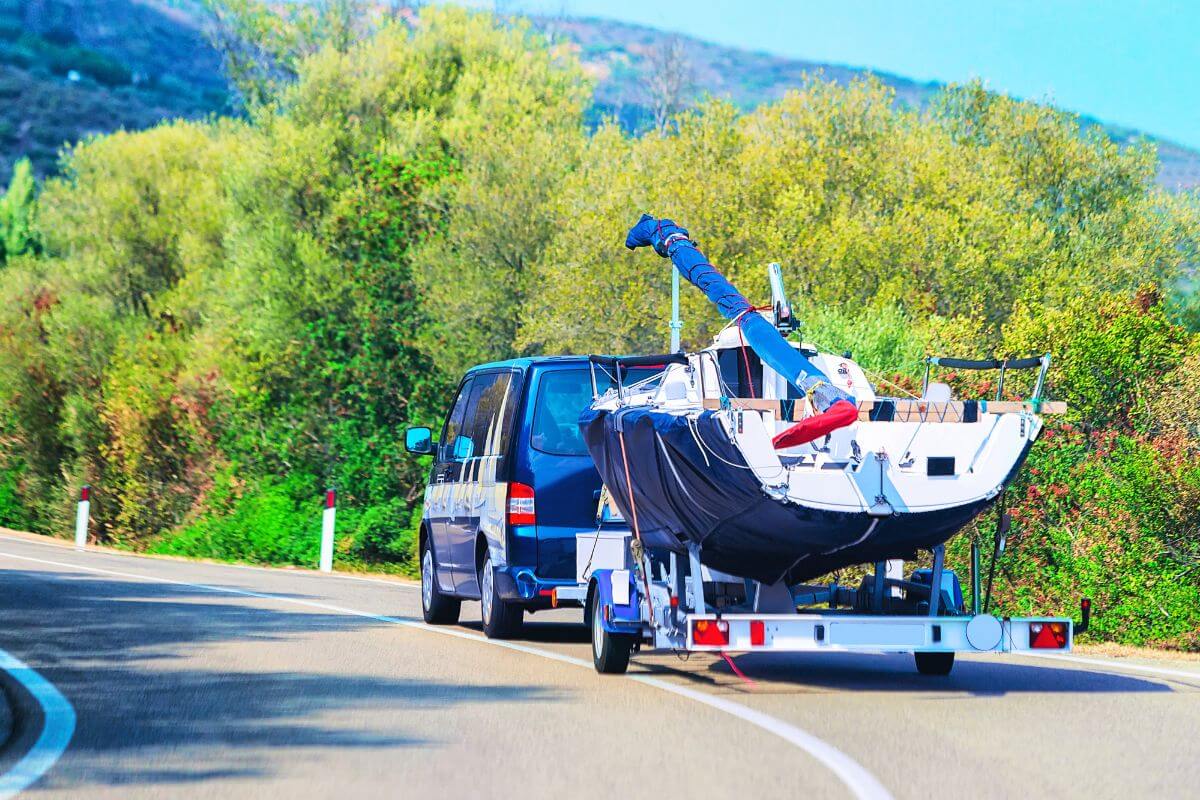
There are affordable beginner sailboats out there
Buying a boat will always cost money, but there are so many second-hand sailboats you can always find a decent deal, or even a free learning boat, as long as you don't immediately want to go out and get yourself a yacht.
In fact, you probably want to consider buying a very small beginner laser to start out. The smaller the boat, the faster you'll learn. Small, light sailboats give you faster and more precise feedback on what you do. And small lasers are pretty inexpensive. You can get good second-hand deals for just a couple of hundred bucks. This also means you can put them on a trailer and store them at home. Saves additional cost. Larger sailboats (22ft and up) get very expensive very quickly, though.
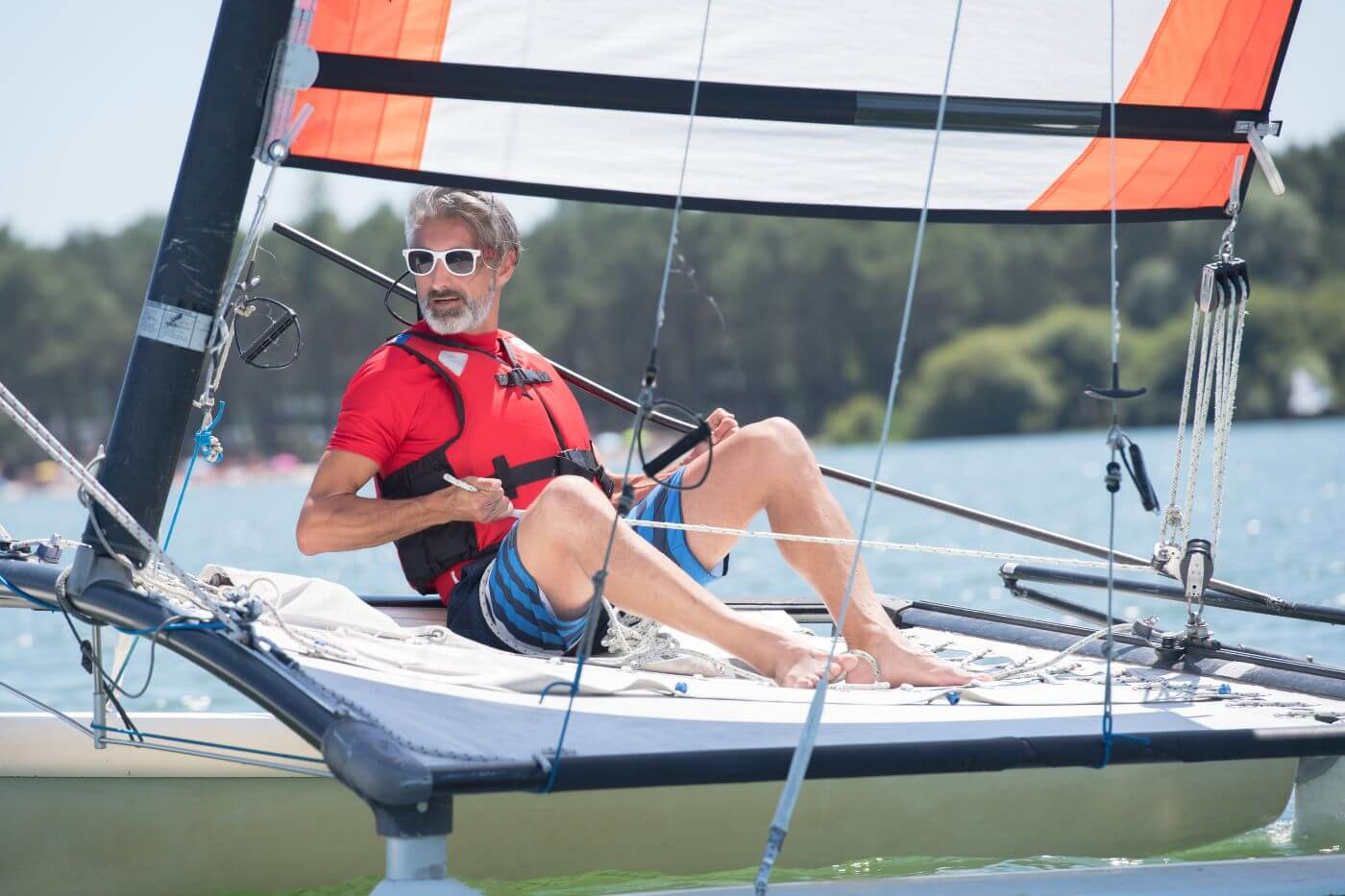
The Average Cost of Buying & Owning a Sailboat I have compared thousands of sailboat prices, and the cost of ownership. In this guide, we'll go over every dollar it will cost to own a boat . If you are unsure what it costs to buy and own a boat (and what's possible on your budget), this is a great resource for you.
But there's more cash-saving good news: you don't necessarily need to own a boat to get started.
You don't need to own a boat to get started
Hiring a boat is pretty straightforward nowadays, and more and more private owners are renting out there boat for fair prices on platforms like Boatsetter (Airbnb for boats). So when first starting out, I recommend renting a sailboat for a couple of weekends first, which should get you a good feel for the whole thing.

You can set sail within a couple of months
Learning to sail can take anywhere between 50 - 500 hours, depending on what level of skill you require. Coastal sailing and ocean passages require a lot more knowledge and experience. In contrast, you can learn to sail your recreational lake in light winds pretty quickly.
You can get started today
It's okay to not be the best sailor straight away. As with any skill worth learning, it's worth doing badly at first. As long as you don't get in anybody's way and stay safe, you can try and fail all you want. That's great because it means you can start today. You don't need hundreds of lessons before setting out on your own.
Some people like to pretend sailing is some mysterious superpower. Sure, doing something really well is always hard, and so is sailing really well. But in the end, we're just catching wind with a piece of cloth. Let's not make it harder than it is.
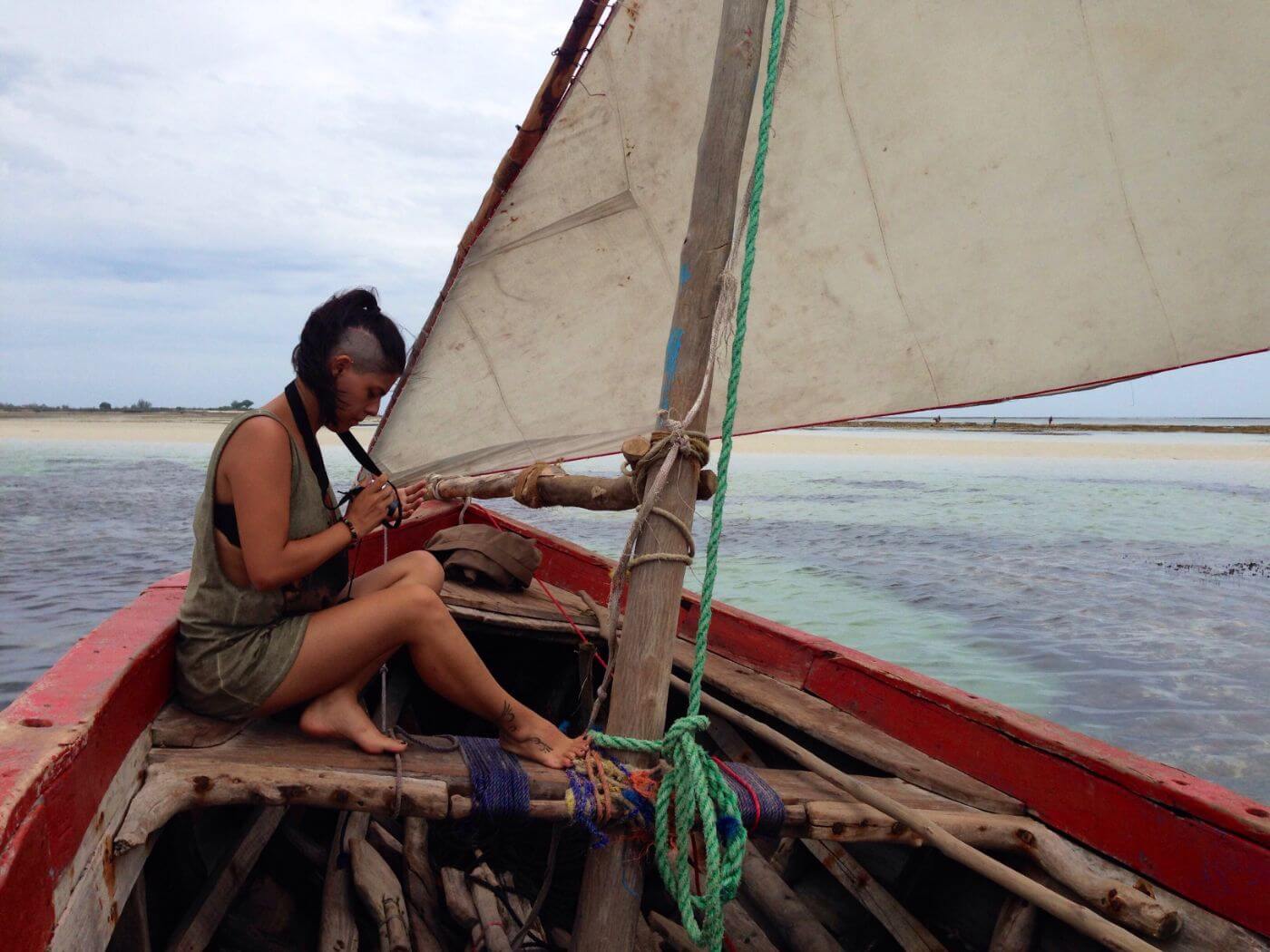
You probably don't even need a license
In some states, you don't need any licenses in order to sail your boat in inland waters. Most states only require you to take a short boater safety exam, which you can do online for roughly $50. After that, you're officially good to go. If you don't require to get a safety license, I still recommend getting one. It's so cheap and easy to get, and it's better to be safe than sorry.
I do recommend getting some basic training before hitting the waters, as operating a boat can be nerve-racking if you're new, and it's just safer if you know the basic rules of the road. More on how to do that later.
For coastal and international waters, you do need multiple licenses, which will take money and time to pass. But when first starting out, you probably want to gain a lot of experience on small bodies of water first.

Okay, so apparently you don't need a huge budget, you don't need dozens of licenses, and you don't need hundreds of lessons before sailing your first boat. You can start today, and nothing's holding you back - you probably get that by now. Except, something is holding you back. Where the heck do you start?
Well, let's start with learning the essential skills before doing anything else.
I have written a very simple approach to learn to sail for practically free (I have linked to it before). Besides being cheap, it's also a good overview of how to go about learning these essential skills. Here's the gist of it:
My 5-step bootstrap plan for new sailors
1. lay the theoretic groundwork.
- Start with free online introductory courses
- Read up on the essential knowledge on Improve Sailing
- Spend time playing Sailaway Sailing Simulator
- Read my recommendation for free courses here .
2. Test where you stand
Now that you have some theoretic knowledge, take two sailing lessons to test where you stand. Don't go overboard on lessons, just get a feel for how quick you learn and how much you know (or don't) already. That way, you don't break the bank and can change your plan accordingly.
3. Gain experience
Next, we want to make sure we have enough experience to stay safe and confident.
- If you are a quick learner , take a 1 or 2-day sailing course. This is a bit more expensive, but it pays off to spend a longer time with someone experienced.
- If you feel like you need more help at first, I recommend trying to become a ship's mate first. This is free and you learn a lot quickly. You can be a ship's mate for a day, a week, or an entire season.
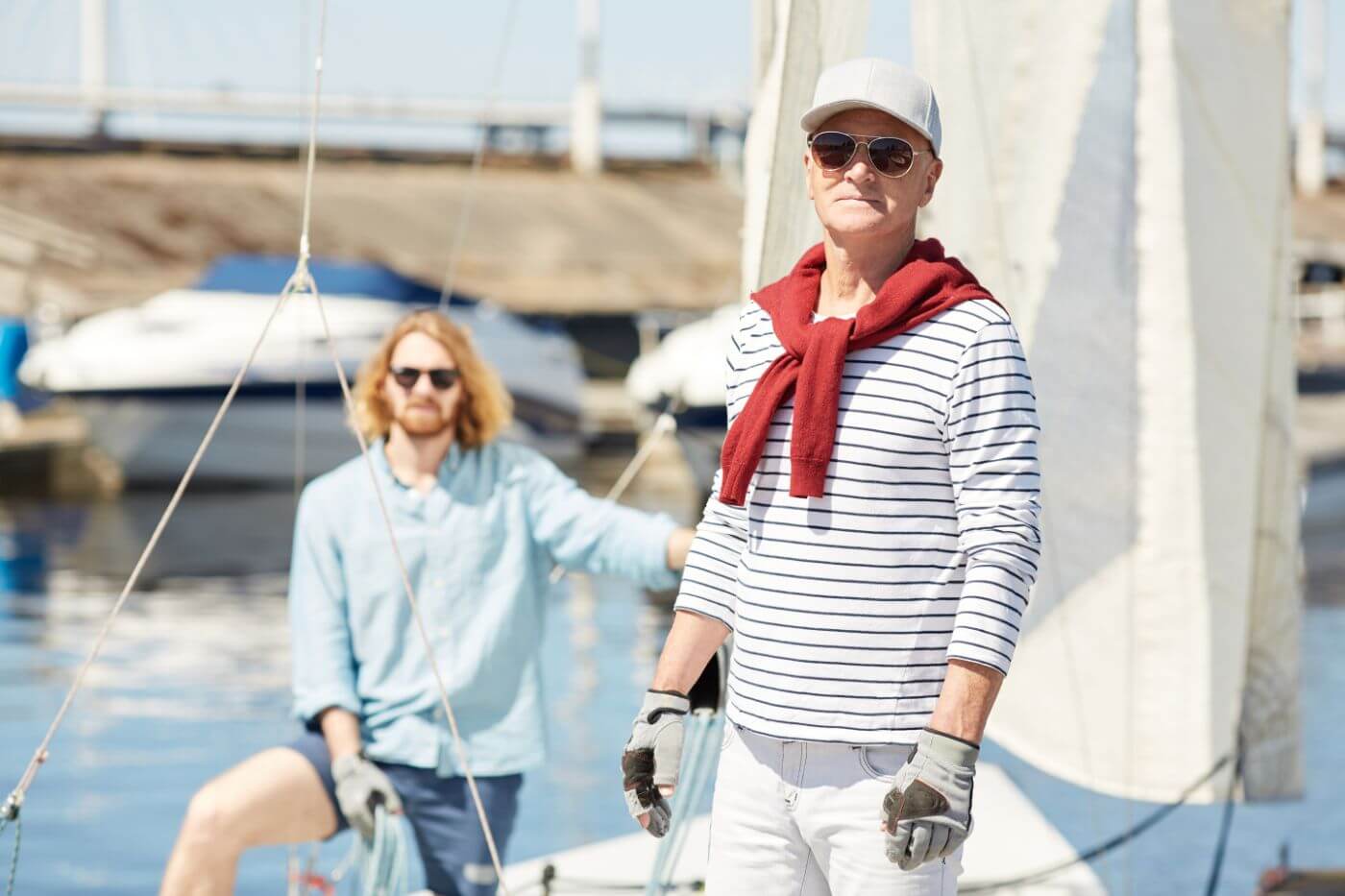
4. Optional: get your license
If you need any licenses, be sure to get them now. In most states, you just need to take a basic boater's safety exam .
5. Set sail
Once you have the basic theoretic knowledge and practical experience, you can finally set sail on your own. I suggest hiring (chartering) a boat at first. This doesn't have to be expensive at all and is a great way to learn what you like and dislike.
General tips when setting sail for the first time
- Start with small boats (under 24') for better feedback
- Sail with light winds of 7 knots or less
- Start small and work your way up
- Safety is always your priority, speed comes second
Let's take a look at the precise skills you need to develop in order to become a good sailor. Below is a quick overview of essential skills and important information, and I'll link to which articles will help you out.

Essential sailing skills
- Marine navigation
- Weather interpretation
If you learn the fundamentals of these five skills, you should be able to stay safe while navigating through most situations. We'll walk through each of those skills, what it involves, and how to learn it below.
Other useful skills that are not essential at first are general boat maintenance, diagnosing electrical issues, and maintaining your boat's engine.
How to learn basic sailing skills
I recommend reading up on basic sailing skills. We have created a special page that shows you what articles we recommend when first starting out . Reading up on sailing skills might seem unnesseccary, but believe me, it really helps to boost your confidence if you have read about all those moving parts ahead of time. It will also save you precious lesson time.
NauticEd offers Basic Sail Trim as one of their free introductory courses , so I recommend taking that course, as well as playing Sailaway, which will really prepare you for trimming sails in real life.
Here's a great beginner sail trim video:
The most important way to learn basic sailing skills, of course, is going out and practising them on the water. I would want to have at least a basic grasp of sail trim and navigation before sailing single-handed (alone).
How to learn marine navigation
I recently wrote a complete guide on how to learn marine navigation . I suggest you start there - it's a very comprehensive guide and great for beginners. I specifically wrote it for people who don't know where to start. In it, I explain the fundamentals and link out to more in-depth articles, so you can explore on your own. Marine navigation is a skill you can train at home especially well.
How to learn anchoring
This is more of a practical skill, but I still recommend to read up on it first (it doesn't cost you anything). William has written a couple of solid articles on anchoring:
- 9 Easy Expert Tips for Anchoring a Boat Near Shore
- How Much Anchor Chain Should You Let Out When Anchoring?
- Can I Moor & Anchor My Boat Anywhere?
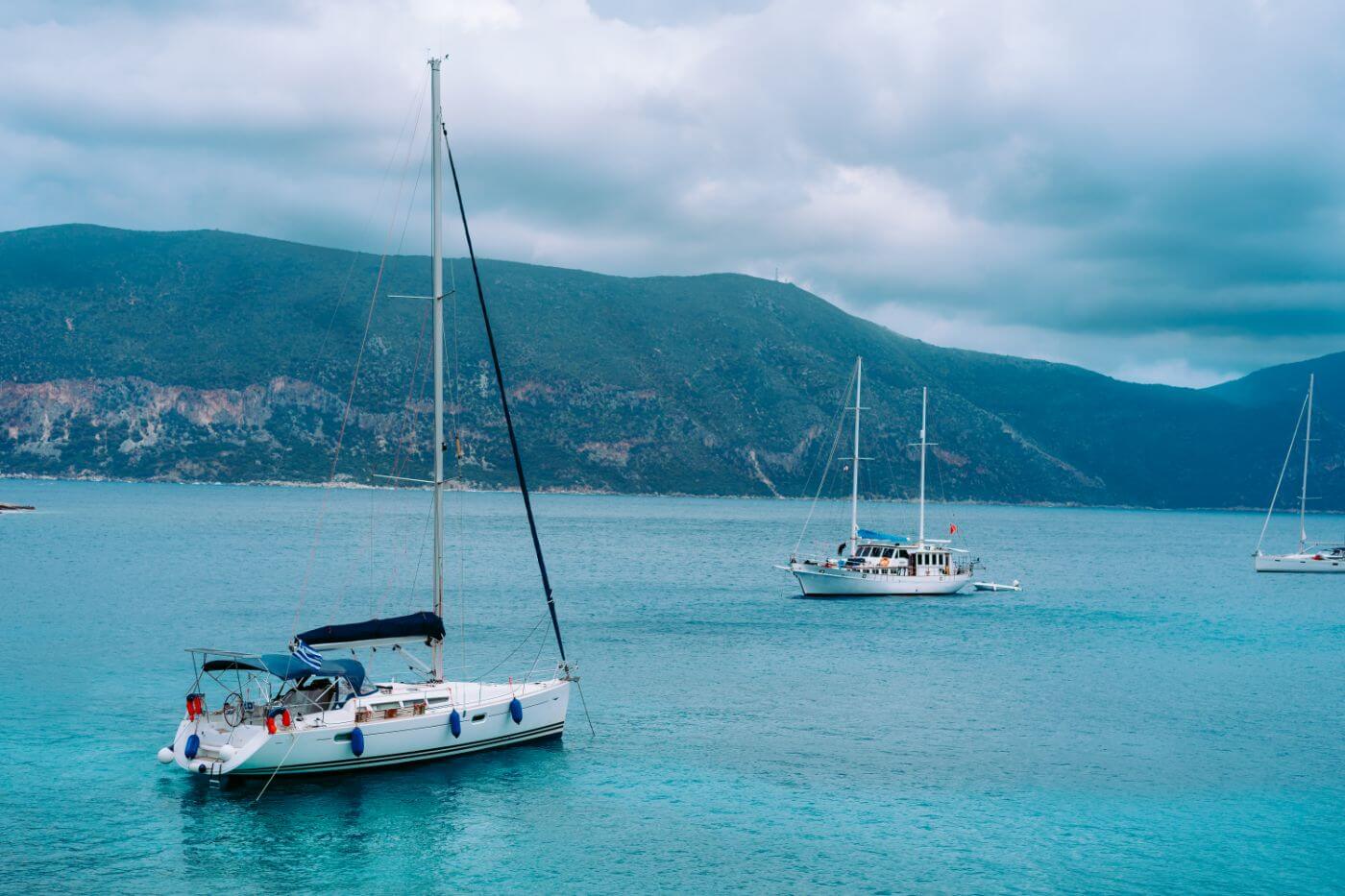
Essential knowledge
Even though sailing is a very hands-on skill, you do need some theoretical knowledge as well.
- Boat Safety Standards
- Rules of the Road - essential in avoiding collisions and dangerous situations
This information is included in one of the free introductory courses offered by NauticEd , and I believe ASA also has a free course on collision rules.
Useful knowledge

Besides this essential information, there are also things that are simply handy to know. It really pays to invest some time into learning the most important sailing terms. I recommend you learn the following at the least:
- Basic parts of sailboats - has great diagrams
- Basic sail names - illustrated guide with examples
- Most common sailing terms - extensive database
Understanding the basic names of things comes in handy when shouting orders at your crew (or being shouted at!), and avoiding any confusion. However, you can definitely sail a boat without knowing the name of everything on it.
There is some basic gear you probably want to have as a first-time sailor. Luckily, there isn't a lot of speciality stuff you have to have when renting your first sailboat.
- suitable shoes & clothing
- basic navigation tools
- optional: plotting tools
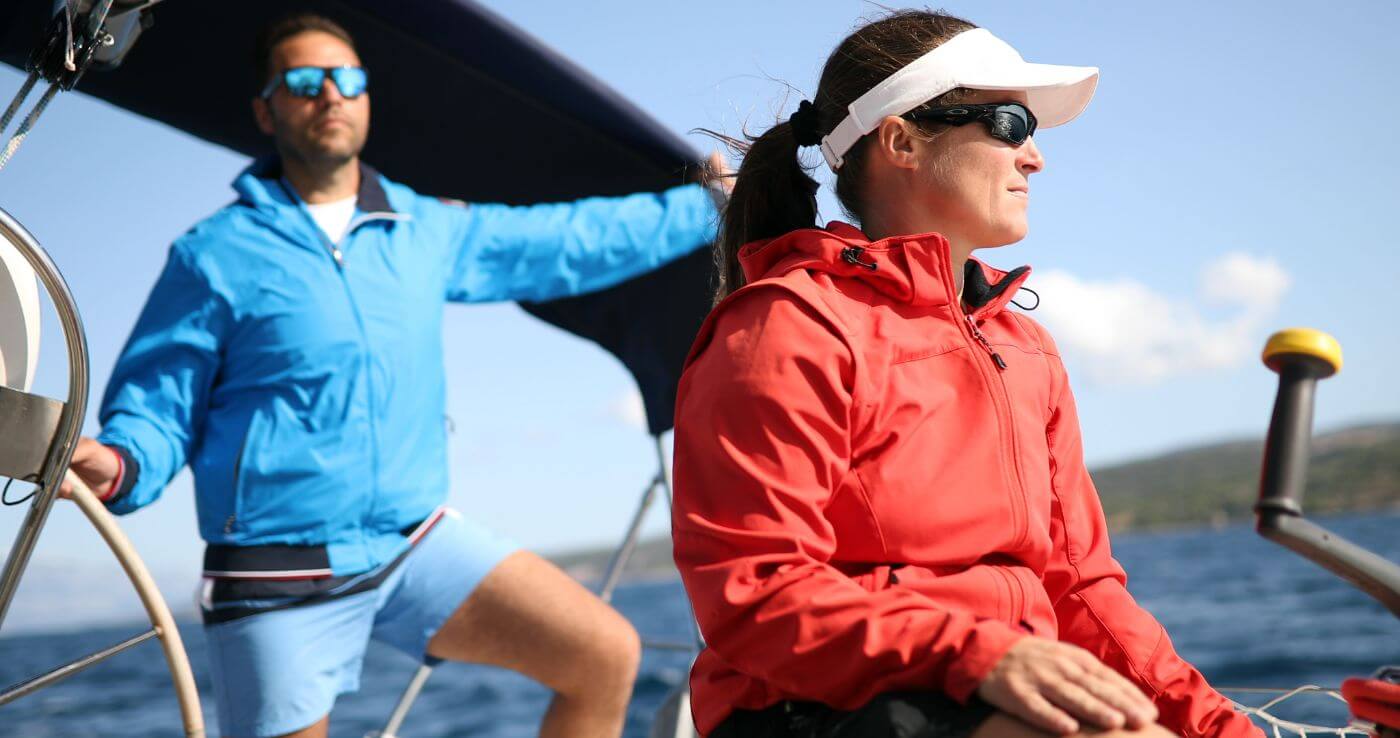
Suitable shoes
If you're just going out sailing for some odd days here and there, you only need suitable shoes to wear onboard. Or you could not wear any shoes at all, which is cheaper obviously. It can pay off to invest in something to protect your pinky toe.
- Here's What Shoes to Wear Sailing (and which not )
Sailing gloves
If you're planning on sailing more often, or longer days, you might want to consider getting a good pair of sailing gloves. Those will really help protect your hands from fatigue, blisters, and rope burn.
I highly recommend getting some kind of headwear. Make sure it has a strap or is a tight fit. Protecting yourself from the sun is important on the water. You get sunburn quickly.
Suitable clothing
You can wear regular clothing. Make sure to bring multiple layers, as temperatures on the water can change quickly. If you have clothes that are lightweight, comfortable, dry quickly, and optionally break wind, that's perfect. You could of course buy special sailing jackets, but these tend to be pricey, and you only really need them if you're on the water a lot.
Here's an expert tip: always bring dry clothes and wrap them in a plastic bag.
- Here's What to Wear Sailing in the UK
If you're looking for good quality sailing gear, I have articles on gear I like. You can check them out on the recommended gear section of this site. It has all the sailing gear I love most.
Navigation tools
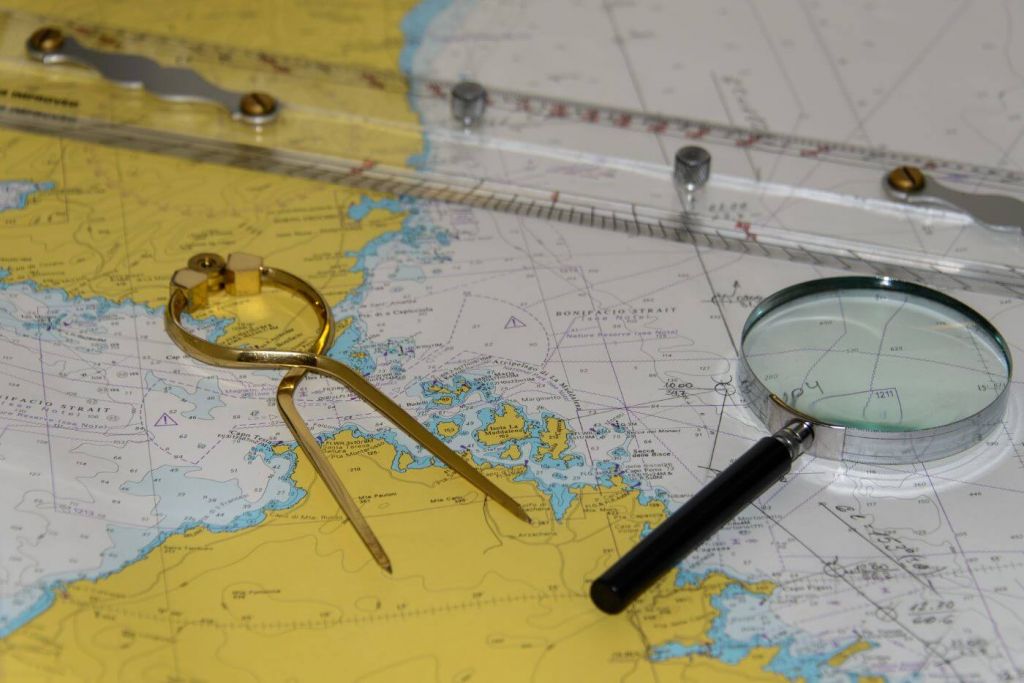
When renting a boat, you want to bring some basic navigational tools:
- handheld magnetic compass
- nautical charts
Most people won't need plotting tools at first, but if you're planning on sailing longer legs, you might want to get them:
- parallel rulers
You might also need to show your skipper's license, or at least your boater's safety license.
Getting into sailing doesn't have to be complex at all. If you bookmark this article, you can get back to it (and the resources I link out to) and work your way through them in your own time. Taking your time to learn the fundamentals right first will greatly speed up your practical learning experience.
While sailing is a practical skill, and more traditional skippers will argue that you can't learn it on paper, I disagree. There is a lot of information that is especially suited to learn online or practice at home. By doing so, you'll feel more confident once you set foot on board. However, you probably shouldn't postpone bolstering your practical experience either. You want to see where you stand as quickly as possible. A lot of people put it off indefinitely, and if there's one thing true about the internet - actually, two -, it is this:
- You can keep reading indefinitely.
- It can't replace the real thing.
Instead, use it as a helpful resource to speed up the process and cut cost. It's a great place to do homework. But now, it's time to step aboard - good luck, and smooth sailing!
Leave a comment
Own your first boat within a year on any budget.
A sailboat doesn't have to be expensive if you know what you're doing. If you want to learn how to make your sailing dream reality within a year, leave your email and I'll send you free updates . I don't like spam - I will only send helpful content.
Ready to Own Your First Boat?
Just tell us the best email address to send your tips to:
Best Small Sailboats for Beginners
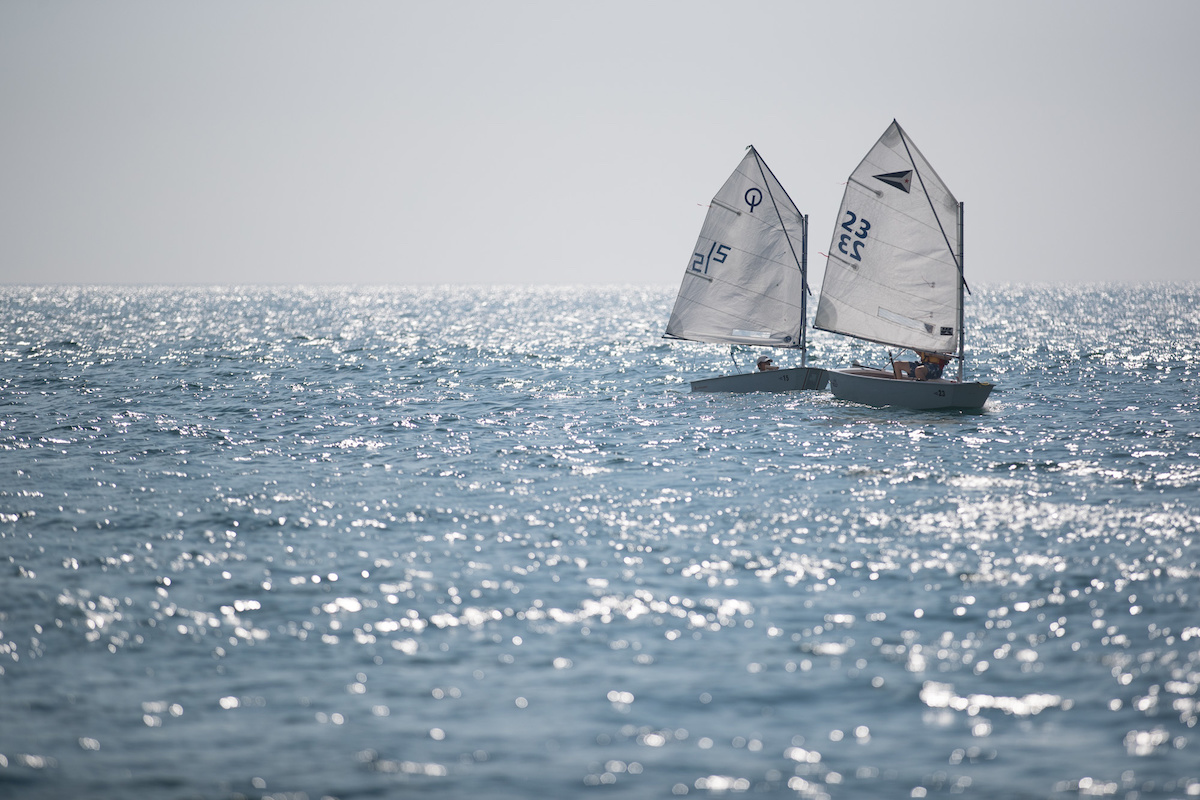
There are a number of classic trainers used by yacht club youth programs as well as techie new designs. Without mentioning specific models and brands, it’s difficult to outline which small boats are best but here are things to look for in good teaching boats.
Some of the best small sailboats for beginners include:
- Boats with tillers steering
- Boats with no winches
- Sailing dinghies
- Small sloops
- Small catamarans
- Rotomolded boats
- Trailerable sailboats
Explore All Sailboat Types
Boats with Tiller Steering
Steering by tiller (rather than a wheel) can make a difference when learning. Tillers are directly connected to the rudder that manages the boat’s direction. Tillers provide quick feedback about the strength and direction of the wind as well as the boat’s turning agility at various speeds.
Boats with No Winches
Boats that require no winches to manage the sheets and halyards are best for youngsters and new sailors. These boats usually don’t experience the same forces on the sails and rigging as larger boats, which can be a handful when the wind starts to blow. Winches are usually replaced with cam or jam cleats, which are easy to use.
Sailing Dinghies
Sailing dinghies are usually rigged with one mast and one sail and offer kids and new sailors simplicity so it’s easy to learn the ropes. Less overwhelming than boats with two sails, dinghies are light and responsive. They also have a shallow draft due to side or centerboards so they can be sailed just about anywhere. In some cases (whether from a wind gust or sudden crew weight shift) sailing dinghies can capsize so students should wear lifejackets and know how to swim. Sailing dinghies are usually sailed by one or two people.
Small Sloops
Small sloops with a mast that carries head and mainsails are the next step so students learn how sails work together. Headsails can be hanked on or attached to a small roller furler. These boats may have some or no winches, which also makes them easier to maintain. These boats can usually be sailed with one to four people.
Some sloops can scale up, providing a more challenging experience for sailors as they develop skills. Certain models can carry spinnakers and larger headsails to teach sail combinations and new sail trim techniques. Others offer the ability to hike out (shift crew weight well outboard to balance the boat against the wind pressure in the sails). This kind of sailing is more advanced.
Small Catamarans
Small catamarans provide extra stability for those who may be nervous about capsizing or aren’t fond of heeling (tipping while sailing). With two hulls providing a wide and stable base, catamarans area ideal for beginners, which may be why they’re often used by resorts as their beach sailing tourist boats. Rigged with one or two sails, small cats are tiller steered and usually have a trampoline that the students sit on and sail.
Rotomolded Boats
Small rotomolded boats are very forgiving due to their durable construction. Unlike fiberglass or wooden boats, rotomolded (a type of plastic construction technique) trainers can bounce off docks or other boats and cause or sustain little damage. Dinghies and catamarans can both be made via rotomolding.
Trailerable Sailboats
Finally, small sailboats that can be trailered to different locations add variety and that makes learning fun. Students can learn to sail in different wind and water conditions and enjoy their boats differently on vacation or with new friends.
Learning to sail involves all the senses and requires a level head and lots of practice and although it can be learned in many ways, the best way is to start with a boat that’s small, simple, safe and durable.
Read Next: Small Boats: What Are My Options?
You Might Also Like:
- Sailing Basics: 10 Nautical & Sailing Terms to Know
- Learning the Basics of Sailing
- Why Sailing?
- Find the Right Boat for Your Lifestyle
- Explore Sailboat Brands
Join Our Newsletter!
Get community news, buying bargains, and how-to guides at your fingertips.

- Find A School
- Certifications
- North U Sail Trim
- Inside Sailing with Peter Isler
- Docking Made Easy
- Study Quizzes
- Bite-sized Lessons
- Fun Quizzes
- Sailing Challenge

Learn to Sail
New sailor resources.
New to Sailing? Start Here!
Take sailing lessons, get asa certified, find a school, 101/103/104 study quizzes, live webinars, online resources.
- Online Courses
ASA Webinars
Textbook library.

- Learn To Sail
- Mobile Apps
- Upcoming Courses
- Sailor Resources
- ASA Log Book
- Bite Sized Lessons
- Knots Made Easy
- Catamaran Challenge
- Sailing Vacations
- Sailing Cruises
- Charter Resources
- International Proficiency Certificate
- Find A Charter
- All Articles
- Sailing Tips
- Sailing Terms
- Destinations
- Environmental
- Initiatives
- Instructor Resources
- Become An Instructor
- Become An ASA School
- Member / Instructor Login
- Affiliate Login
Small Sailboat Lessons
By captain, coach and professor floyd jay winters, private sailing lessons.
Learn on an easy-to-sail 17-foot WindRider Trimaran sailboat or on the classic Sunfish. The WindRider 17 is very stable and forgiving beach-launched sailboat, rigged with both a mainsail and a jib. Captain F Jay Winters also gives lessons on the single-sail 14-foot Sunfish and the faster Laser sailboats. Lessons are given at Bimini Bay Sailing on Anna Maria Island, minutes away from Bradenton, Sarasota, and Longboat Key. For private sailing lessons, contact Jay at [email protected] and he will call you back quickly.
Captain Jay has taught small sailboat sailing at Bimini Bay Sailing to hundreds of students, ranging in age from as young as 7 to over 70. Most instruction is offered on 17-foot WindRider trimarans, 14-foot Sunfish and Lasers. He also teaches a Beginners Sailing course, a Sail Trim course, and America's Boating Course for the Anna Maria Island Sail and Power Squadron . Jay has sailed, crewed, and raced on all sizes of boats, ranging from the 14-foot Sunfish to 36-foot keelboats to the historic 122-foot Baltimore Clipper Schooner, the Privateer Lynx .
If you or your child want to learn to sail on a pram, dinghy or a small sailboat, and if you are in the Bradenton, Palmetto, Sarasota, Longboat Key, Anna Maria area, feel free to contact Captain Jay for personalized sailing lessons on either a WindRider 17 or a Sunfish or a Laser. With Jay's coaching techniques, the average new sailor can learn to sail a WindRider Trimaran in two to three hours. The average student can learn to sail a Sunfish in three to five hours. And of course, purchasing the Learn Sailing Fun And Easy book beforehand will make the experience even more enjoyable.
Small Boat Rentals
Capri / j-24 / soling 26’.
Enjoy an easy afternoon sail aboard a stable J-24′, Soling 26′ or Capri 22’! Please note: sailing experience is required in addition to passing our small boat sailing quiz in person on the day of your rental.
Known for its sweet sailing performance in nearly all conditions, the Catalina Capri 22′ has been winning over sailors since its introduction. The Capri 22 is more comfortable, safer at sea, and easier to maintain than other boats in its class. Its striking deck profile is flared across the stern and its wide cockpit curves are comfortable for crew both during and after sailing.
HOURLY: $65/hour
DAILY: $260/day
CAPACITY: 6 people
Please note that reservations are only available for day sail rentals. All hourly rentals are done on a walk-in, first come, first served basis.
The J-24′ is one of the most popular one design racers in the world. Also a great daysailer, the J-24′ is maneuverable and responsive. With a spacious and workable deck and small cabin below, it is a top pick for sailing education. Additionally, it is equipped with an auxiliary electric motor for easy launching and docking. It is a very stable boat and able to handle challenging cruising conditions.
HOURLY: $80/hour
DAILY: $320/day
CAPACITY: 5 people
The Soling 26′ was designed as an Olympic class racer and is built for speed. Quick and responsive, the Soling handles well under most conditions and its simplified running rigging makes it even easier to sail. It lacks only the creature comforts of a cruising yacht and more than makes up for it with the thrill of a “go fast” afternoon sail. Features include a main traveler, hiking straps and a tiller extension.
HOURLY: $65/hour
CAPACITY: 4 people
What kind of experience do I need to take out a small sailboat? Do I need to take a test? You must have experience sailing keelboats. This can include ASA certification, sea time, or a combination of both. Additionally, you must pass our written small boat sailing quiz in office your first time sailing with us, and if it’s been more than a year since you last visited.
How do I make a reservation? For day sails, you can make a reservation online. All hourly rentals are made on a first come, first serve, in person basis.
Do you rent motorboats? We do not. We only rent sailboats to qualified sailors. For inexperienced sailors, we offer small boat lessons and ASA certification courses.
How do I purchase Frequent Sailing Hours? You can purchase Frequent Sailing Hours in person during business hours. Members get additional savings!
How do I use my hours? Frequent Sailing Hours can be used toward hourly rentals on a walk-in basis only.
Frequent Sailing Hours
Prepay for 12 hours of small boat rental time and receive 25% savings. Hours can be applied toward hourly rentals of our J-24’S, Capri 22’s and Soling 26’. Package of 12 Frequent Sailing Hours: $653 + tax. Members get 25% off. Purchase in person.
Looking to Learn?
Enjoy a 2-4 hour lesson with one of our instructors aboard a Capri 22′ or J-24. 4 person maximum.
2 Hours $210
3 Hours $280
4 Hours $350
Privacy Preference Center
Privacy preferences.
Double Dolphin Private Cruise – 1 Hour

10 Best Small Sailboats (Under 20 Feet)

Last Updated by
Daniel Wade
December 28, 2023
Compact, easy to trailer, simple to rig, easy to maintain and manage, and affordable, the best small boats all have one thing in common: they offer loads of fun while out there on the water.
So whether you're on a budget or just looking for something that can offer ultimate daytime rides without compromising on safety, aesthetic sensibilities, alternate propulsion, and speed, the best small sailboats under 20 feet should be the only way to go.
Let's be brutally honest here; not everyone needs a 30-foot sailboat to go sailing. They come with lots of features such as electronics, entertainment, refrigeration, bunks, a galley, and even a head. But do you really need all these features to go sailing? We don't think so.
All you need to go sailing is a hull, a mast, rudder, and, of course, a sail. And whether you refer to them as daysailers, trailerable sailboats , a weekender sailboat, or pocket cruisers, there's no better way to enjoy the thrills of coastal sailing than on small sailboats.
There are a wide range of small boats measuring less than 20 feet available in the market. These are hot products in the market given that they offer immense thrills out on the sea without the commitment required to cruise on a 30-footer. A small sailboat will not only give you the feel of every breeze but will also give you the chance to instantly sense every change in trim.
In this article, we'll highlight 10 best small sailboats under 20 feet . Most models in this list are time-tested, easy to rig, simple to sail, extremely fun, and perfect either for solo sailing or for sailing with friends and family. So if you've been looking for a list of some of the best small sailboats , you've come to the right place.
So without further ado, let's roll on.
Table of contents
{{boat-info="/boats/hunter-15"}}
The Marlow-Hunter 15 is not only easy to own since it's one of the most affordable small sailboats but also lots of fun to sail. This is a safe and versatile sailboat for everyone. Whether you're sailing with your family or as a greenhorn, you'll love the Hunter 15 thanks to its raised boom, high freeboard, and sturdy FRP construction.
With high sides, a comfortable wide beam, a contoured self-bailing cockpit, and fiberglass construction, the Hunter 15 is certainly designed with the novice sailor in mind. This is why you can do a lot with this boat without falling out, breaking it, or capsizing. Its contoured self-baiting cockpit will enable you to find a fast exit while its wide beam will keep it steady and stable no matter what jibes or weight shifts happen along the way.
This is a small sailboat that can hold up to four people. It's designed to give you a confident feeling and peace of mind even when sailing with kids. It's easy to trailer, easy to rig, and easy to launch. With a price tag of about $10k, the Hunter 15 is a fun, affordable, and versatile boat that is perfect for both seasoned sailors and novices. It's a low-maintenance sailboat that can be great for teaching kids a thing or two about sailing.
Catalina 16.5
{{boat-info="/boats/catalina-16-5"}}
Catalina Yachts are synonymous with bigger boats but they have some great and smaller boats too such as Catalina 16.5. This is one of the best small sailboats that are ideal for family outings given that it has a big and roomy cockpit, as well as a large storage locker. Designed with a hand-laminated fiberglass sloop, the Catalina 16.5 is versatile and is available in two designs: the centerboard model and the keel model.
The centerboard model is designed with a powerful sailplane that remains balanced as a result of the fiberglass centerboard, the stable hull form, and the rudder. It also comes with a tiller extension, adjustable hiking straps, and adjustable overhaul. It's important to note that these are standard equipment in the two models.
As far as the keel model is concerned, this is designed with a high aspect keel as the cast lead and is attached with stainless steel keel bolts, which makes this model perfect for mooring or docking whenever it's not in use. In essence, the centerboard model is perfect if you'll store it in a trailer while the keel model can remain at the dock.
All in all, the Catalina 16.5 is one of the best small sailboats that you can get your hands on for as low as $10,000. This is certainly a great example of exactly what a daysailer should be.
{{boat-info="/boats/hobie-16"}}
There's no list of small, trailerable, and fun sailboats that can be complete without the inclusion of the classic Hobie 16. This is a durable design that has been around and diligently graced various waters across the globe since its debut way back in 1969 in Southern California. In addition to being durable, the Hobie 16 is trailerable, great for speed, weighs only 320 pounds, great for four people, and more importantly, offers absolute fun.
With a remarkable figure of over 100,000 launched since its debut, it's easy to see that the Hobie 16 is highly popular. Part of this popularity comes from its asymmetric fiberglass-and-foam sandwiched hulls that include kick-up rudders. This is a great feature that allows it to sail up to the beach.
For about $12,000, the Hobie 16 will provide you with endless fun throughout the summer. It's equipped with a spinnaker, trailer, and douse kit. This is a high-speed sailboat that has a large trampoline to offer lots of space not just for your feet but also to hand off the double trapezes.
Montgomery 17
{{boat-info="/boats/montgomery-17"}}
Popularly known as the M-17, The Montgomery 17 was designed by Lyle C. Hess in conjunction with Jerry Montgomery in Ontario, California for Montgomery Boats. Designed either with keel or centerboard models, the M-17 is more stable than most boats of her size. This boat is small enough to be trailered but also capable of doing moderate offshore passages.
This small sailboat is designed with a masthead and toe rail that can fit most foresails. It also has enough space for two thanks to its cuddly cabin, which offers a sitting headroom, a portable toilet, a pair of bunks, a DC power, and optional shore, and a proper amount of storage. That's not all; you can easily raise the deck-stepped mast using a four-part tackle.
In terms of performance, the M-17 is one of the giant-killers out there. This is a small sailboat that will excel in the extremes and make its way past larger boats such as the Catalina 22. It glides along beautifully and is a dog in light air, though it won't sail against a 25-knot wind, which can be frustrating. Other than that, the Montgomery 17 is a great small sailboat that can be yours for about $14,000.
Norseboat 17.5
{{boat-info="/boats/norseboat-17-5"}}
As a versatile daysailer, Norseboat 17.5 follows a simple concept of seaworthiness and high-performance. This small sailboat perfectly combines both contemporary construction and traditional aesthetics. Imagine a sailboat that calls itself the "Swiss Army Knife of Boats!" Well, this is a boat that can sail and row equally well.
Whether you're stepping down from a larger cruiser or stepping up from a sea kayak, the unique Norseboat 17.5 is balanced, attractive, and salty. It has curvaceous wishbone gaff, it is saucy, and has a stubby bow-sprit that makes it attractive to the eyes. In addition to her beauty, the Norseboat 17.5 offers an energy-pinching challenge, is self-sufficient, and offers more than what you're used to.
This is a small, lightweight, low-maintenance sailboat that offers a ticket to both sailing and rowing adventures all at the same time. At about 400 pounds, it's very portable and highly convenient. Its mainsails may look small but you'll be surprised at how the boat is responsive to it. With a $12,500 price tag, this is a good small sailboat that offers you the versatility to either row or sail.
{{boat-info="/boats/sage-marine-sage-17"}}
If you've been looking for a pocket cruiser that inspires confidence, especially in shoal water, look no further than the Sage 17. Designed by Jerry Montgomery in 2009, the Sage 17 is stable and should heel to 10 degrees while stiffening up. And because you want to feel secure while sailing, stability is an integral feature of the Sage 17.
This is a sailboat that will remain solid and stable no matter which part of the boat you stand on. Its cabin roof and the balsa-cored carbon-fiber deck are so strong that the mast doesn't require any form of compression post. The self-draining cockpit is long enough and capable of sleeping at 6 feet 6 inches.
The Sage 17 may be expensive at $25k but is a true sea warrior that's worth look at. This is a boat that will not only serve you right but will also turn heads at the marina.
{{boat-info="/boats/laserperformance-laser-sb3"}}
Having been chosen as the overall boat of the year for 2008 by the Sailing World Magazine, the Laser SB3 is one of the coolest boats you'll ever encounter. When sailing upwind, this boat will lock into the groove while its absolute simplicity is legendary. In terms of downwind sailing, having this boat will be a dream come true while it remains incredibly stable even at extraordinary speed.
Since its debut in 2004, the Laser SB3 has surged in terms of popularity thanks to the fact that it's designed to put all the controls at your fingertips. In addition to a lightweight mast, its T- bulb keel can be hauled and launched painlessly. For about $18,000, the Laser SB3 ushers you into the world of sports sailing and what it feels to own and use a sports boat.
{{boat-info="/boats/fareast-18"}}
As a manufacturer, Fareast is a Chinese boat manufacturer that has been around for less than two decades. But even with that, the Fareast 18 remains a very capable cruiser-racer that will take your sailing to the next level. In addition to its good looks, this boat comes with a retractable keel with ballast bulb, a powerful rig, and an enclosed cabin.
Its narrow design with a closed stern may be rare in sailboats of this size, but that's not a problem for the Fareast 18. This design not only emphasizes speed but also makes it a lot easier to maintain this boat. Perfect for about 6 people, this boat punches above its weight. It's, however, designed to be rigged and launched by one person.
This is a relatively affordable boat. It's agile, safe, well-thought-out, well built, and very sporty.
{{boat-info="/boats/chuck-paine-paine-14"}}
If you're in the market looking for a small sailboat that offers contemporary performance with classic beauty, the Paine 14 should be your ideal option. Named after its famous designer, Chuck Paine, this boat is intentionally designed after the classic Herreshoff 12.5 both in terms of dimensions and features.
This is a lightweight design that brings forth modern fin keel and spade rudder, which makes it agile, stable, and faster. The Paine 14 is built using cold-molded wood or west epoxy. It has varnished gunnels and transoms to give it an old-time charm. To make it somehow modern, this boat is designed with a carbon mast and a modern way to attach sails so that it's ready to sail in minutes.
You can rest easy knowing that the Paine 14 will not only serve you well but will turn heads while out there.
{{boat-info="/boats/wd-schock-lido-14"}}
Many sailors will attest that their first sailing outing was in a Lido 14. This is a classic sailboat that has been around for over four decades and still proves to be a perfect match to modern small boats, especially for those still learning the ropes of sailing.
With seating for six people, the Lido 14 can be perfect for solo sailing , single-handed sailing, or if you're planning for shorthanded sailing. While new Lido 14 boats are no longer available, go for a functional used Lido 14 and you'll never regret this decision. It will serve you well and your kids will probably fall in love with sailing if Lido 14 becomes their main vessel during weekends or long summer holidays.
Bottom Line
There you have it; these are some of the best small sailboats you can go for. While there are endless small sailboats in the market, the above-described sailboat will serve you right and make you enjoy the wind.
Choose the perfect sailboat, invest in it, and go out there and have some good fun!
Related Articles
I've personally had thousands of questions about sailing and sailboats over the years. As I learn and experience sailing, and the community, I share the answers that work and make sense to me, here on Life of Sailing.
by this author
Best Sailboats
Most Recent

What Does "Sailing By The Lee" Mean?
October 3, 2023

The Best Sailing Schools And Programs: Reviews & Ratings
September 26, 2023
Important Legal Info
Lifeofsailing.com is a participant in the Amazon Services LLC Associates Program, an affiliate advertising program designed to provide a means for sites to earn advertising fees by advertising and linking to Amazon. This site also participates in other affiliate programs and is compensated for referring traffic and business to these companies.
Similar Posts

Affordable Sailboats You Can Build at Home
September 13, 2023

Best Small Sailboats With Standing Headroom

Best Bluewater Sailboats Under $50K
Popular posts.

Best Liveaboard Catamaran Sailboats

Can a Novice Sail Around the World?
Elizabeth O'Malley
June 15, 2022

4 Best Electric Outboard Motors

How Long Did It Take The Vikings To Sail To England?

10 Best Sailboat Brands (And Why)
December 20, 2023

7 Best Places To Liveaboard A Sailboat
Get the best sailing content.
Top Rated Posts
Lifeofsailing.com is a participant in the Amazon Services LLC Associates Program, an affiliate advertising program designed to provide a means for sites to earn advertising fees by advertising and linking to Amazon. This site also participates in other affiliate programs and is compensated for referring traffic and business to these companies. (866) 342-SAIL
© 2024 Life of Sailing Email: [email protected] Address: 11816 Inwood Rd #3024 Dallas, TX 75244 Disclaimer Privacy Policy

Willamette Sailing Club
Learn-to-sail, 2024 registration is open.
Youth Summer Camps
Adult Classes
Private lessons.
Youth Race Teams
Custom Events
Scroll down to learn more and register…
The Willamette Sailing Club is located on the banks of the Willamette River, approximately 5 minutes south of downtown Portland. It is the only small boat sailing club in Portland, and is dedicated to dinghy (non-keelboats under 20 feet) sailing and racing.
The club hosts Learn-to-Sail classes taught by US Sailing certified instructors during the spring, summer and fall, with over 500+ students coming through our program annually! We offer classes for every age and level of experience. Whatever your sailing interest is, WSC is a welcoming club that provides a great opportunity to get out on the river and enjoy some family fun in a safe, comfortable, and scenic environment.
Empowering all people to get out on the water and explore!
The Willamette Sailing Club (WSC) is committed to creating a safe, positive, and inclusive environment for all people regardless of race, gender, sexual orientation, religious affiliation, national origin, age, identity, education, disability, or other protected status. WSC is welcoming and proud of its diverse membership and guests.
We’re committed to modeling diversity and inclusion for the sailing community and to maintaining an inclusive environment with equitable treatment for all.
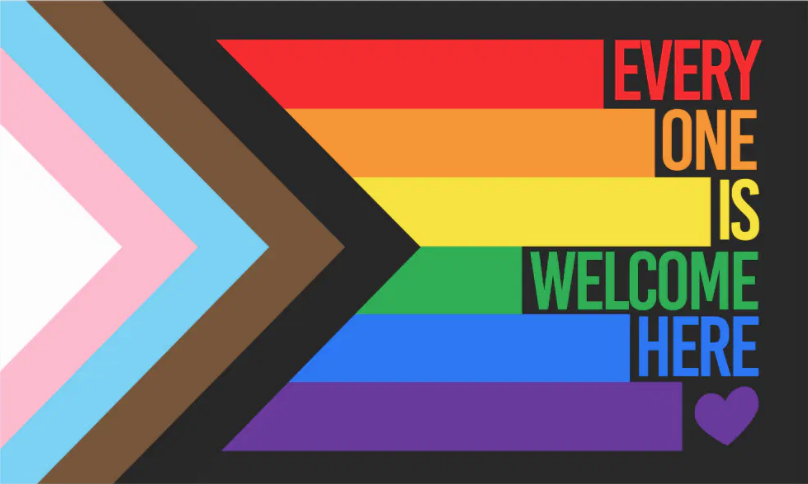
Minnows (Ages 5-7)
Young sailors spend the mornings sailing, swimming, and learning about the river in our protected harbor. The goal is to help young kids feel comfortable around the water in a safe and fun environment. Lifejackets required at all times. No swim check required.

Youth Classes (Ages 8-11)
Youth learn the basics of small boat sailing through hands on learning and fun games that are designed to practice boat handling and water safety. Ages 8-11 learn to sail in one person Optimists. All sailors are required to demonstrate their ability to swim by completing a 50-foot swim check and capsize drill WITH a lifejacket.

Teen Classes (Ages 12-18)
Teens learn the basics of small boat sailing while doing drills and fun games designed to practice boat handling skills. A great introduction to sailing! Ages 12-18 learn to sail in two person, 14 ft. Club 420s. All sailors will be expected to complete a 50-foot swim check and capsize drill WITH a lifejacket.

Using US Sailing’s Beginner Curriculum, students learn the basics of rigging, sailing theory, safety, knots, docking and right of way rules in our two person, 14 ft. Club 420s. Classes concentrate on teaching the basics of sailing, while spending as much time as possible on the water. Participants must know how to swim and will be asked to complete a 50-foot swim test and capsize drill WITH a lifejacket.

Private lessons are a great way to learn or advance your skills while sailing individually, with a friend or with the whole family. Private lessons allow coaches to give personalized feedback and teach to your particular skill level. During private lessons, your coach will be alongside you in a powerboat. Lessons last three hours and can be taught in your privately owned boat, or one of the club’s C420s, Lasers, Lidos, Daysailers, or Optis.

Team Willamette (Ages 8-18)
If your sailor has completed a learn-to-sail class with us, or has prior sailing experience in another program, they are eligible to join one of our summer intermediate or advanced teams. Ages 8-12 can choose between the intermediate Green Team (Optimists), or the advanced Race Team (Optimists & FJs). Ages 12-18 choose between the intermediate Blue Team (C420s & Lasers), or the advanced Red Team (C420s & Lasers).

Custom Events & Classes
Our sailing club hosts a number of different special events throughout the year: everything from elementary school field trips to public family boat builds to private sailing events. Get in touch if you’d like to schedule a private event, or class, and check back for public events as they develop.
“It’s just awesome to see people exploring the river, going under a bridge, or sailing around an island. It’s a chance to see Portland in a whole new way!”

“Adventure Gear Insider is reader supported. We may make a small commission at no extra cost to you should you make a purchase through links from this site. Learn more ”
The Best Small Sailboat For Beginners. 8 Great Boat Options

If you are new to sailing and want to get a boat, what should you get? There are tons of sailboats out there on Craigslist, eBay, and Marketplace. Prices can range from free to a hundred thousand or more. What should you get for your first sailboat? Keep reading below to learn a little more about sailboats and what you should look for. I also have my picks for the best small sailboat for beginners.
What makes a sailboat good for beginners?
I learned to sail in middle school and have done it regularly since then. I spent my college summers working as a children’s sailing school instructor at a few yacht clubs around the US. I’ve raced sailboats a ton too on all kinds of boats from collegiate buoy racing too overnight long distance races. After years of doing this, I am way more of a go sailing for fun kind of guy than someone who lives for the competition.
For anyone thinking about learning to sail, it’s not that hard to learn sailing basics. You can teach yourself watching Youtube vidoes but it wouldn’t hurt to take a sailing lesson just to learn the basic sailing terms and see a live hands on demonstration of how to sail.
Here is what I have learned over the years for which boats make learning to sail easier.
Easy to sail
You need a boat that is easy to sail. You don’t want to get a boat that capsizes super easily. You want a stable boat that can tolerate some mistakes without sending you into the drink. You want a boat that isn’t too overpowered so it won’t feel terrifying if the wind picks up while you are out.
Easy to rig
You want a boat you can rig and put together easily. If it’s a trailerable boat you need a mast you can put up and down without hurting your back or needing a bunch of tricks. A racing boat with a lot of sail controls may have a ton of things you need to hook up when rigging it and lots of adjustments depending on wind conditions. A recreational day sailing boat may have very few. As a beginner sailor looking for a boat, less is more. You want something that leans towards, lift the mast, put the sails on, hoist, and go.
What exactly is a small sailboat anyways? A read an article recently in a popular sailboat cruising magazine. They labeled a 36 footer as a “compact cruising yacht”. There is nothing compact or small about a 36 footer. Bigger sailboats react slower to steering and sail controls. A larger boat will have a lot more momentum when you are trying to get on and off the dock. The bigger the boat, the more load and force on all the lines and sails.
I recommend learning to sail first on something simple like a Sunfish. A little 14 foot sailing dinghy that can hold 1 or 2 adults. If your more ambitious and want to start with a boat you could go cruising in then a Catalina 25 or 27 are good choices. You really should not go any bigger than that for your first boat. A Catalina 30 weighs twice as much as a Catalina 27 and you can’t just easily push it around the dock. A 30 footer should be saved for your second or later boat.
Dinghy vs keelboat
Your first sailboat can be a dinghy without a keel or a keelboat. Small keelboats can make really good learning boats. With most keelboats you don’t need to worry about capsizing. If you go with a dinghy get something that is easy to upright.
Flying Scots are used for learning sailboats in many places including a sailing club I used to belong too. They are big stable and tubby. They are horrible to upright if you do manage to capsize them. You will need help from a powerboat to do it. If you go for a dinghy with no keel, it is better to stick to 15 feet or under so you can upright it without outside help. The 16 to 20 foot dinghy is where it can take some skill to self rescue yourself after a capsize if it’s possible at all.
If you decide to get a 20 to 25 foot keelboat, it is easiest to keep them at a marina with a hoist or preferably in the water. Trailer launching keelboats is a challenge even with a swing keel because of how deep you need to get them in the water to float off the trailer.
Minimal sail controls
When you learn to sail, all you really need are a halyard to hoist the mainsail, a sheet to control the mainsail. You don’t really need anything else to be adjustable. That is all you need to sail upwind, downwind, or any other point of sail. Everything else is extra for a beginner.
1 or 2 sails
When you learn to sail all you need is a mainsail. The near perfect learning sailboat is the Sunfish which has a lateen rig with only 1 sail. It has really simple controls and you can rig it wrong and it will still sail for you.
It is okay to learn to sail on a sloop rigged boat with 2 sails. A mainsail and a headsail or jib. Stop there.
You don’t need a spinnaker. Ask anyone who has raced sailboats and they will have stories about what went wrong with a spinnaker. Spinnakers are responsible for breaking more stuff on a sailboat than anything else.
There are boats out there with 2 or more masts such as a ketch or yawl. The second mast is called a mizzen mast. Don’t even think of getting one of these either. It’s just more distraction and things that can break or go wrong. You don’t want a cutter rigged sloop. These have 2 headsails which you again don’t need or want.
Tiller steering
Your first boat should have tiller steering. Don’t get a boat with wheel steering. The wheel mechanism has a lot of drag and slop in it and you won’t feel how the boat is reacting. A tiller lets you immediately feel the boat is out of balance. A tiller is easier to learn to sail upwind with by learning to push it towards or away from the sail. Wheel steering is less intuitive. Stay away from that big cruise with a wheel.
Trailerable boats vs marinas
I grew up in central Pennsylvania where we had small lakes to sail on. This meant a trailerable small boat when we got our first sailboat. I currently live in Michigan near the Great Lakes. Most boats I’ve had as an adult have lived at a marina and not at my house.
If you want to sail more often, keep it rigged at a marina so you have to do the very least possible to get it out on the water. I use my sailboats way more often when I don’t have to hook it up to a car, drag it to the lake, rig it and do the reverse to go home. The downside is cost. Keeping even a Sunfish at a marina or yacht club can cost a lot.
If you want to experience sailing on a low budget, trailering smaller boats is a fine way to go. If you want more convenience and your willing to pay for it consider keeping your boat rigged at a marina.
Portable boats (multi-section hull or inflatable)
There are a few new entries in the boating world that focus on making the boat easier to store and transport. These involve either inflatable hulls or a folding or multi-section hull. These let you store the boat in your garage, large closet or spare room. You can fit them in the back of a small SUV for transport without roof racks or a trailer. 2 great examples of these are the Tiwal inflatable sailboat and Minicat inflatable catamaran.
Commonly available and easy to get parts
Stuff will break on your sailboat if you use it enough. Some parts on a boat are really generic such as pullies, blocks and lines. Other parts are not such as boom or mast end fittings, rudders, etc… There are a lot of cheap boats out on Craigslist. There are a million old 15 foot 2 person sloop rigged sailing dinghies out there in people’s yards. Before buying any of these make sure that all the parts are there. Do not buy one without seeing it rigged with sails up first.
If your not sure find an experienced sailor friend who sails to go look at it with you. If anything is broken look up to see if you can get a replacement part. For many of these old boats, replacement parts are impossible to find which is why they are being given away for not much or free.
If a boat has an active racing class still, there is a good chance replacement parts are available. Racers go out in high winds and push the boat which means they break stuff. Boats like a Sunfish or Laser that are still produced and raced all over are easy to get sails and spare parts.
Keep it inexpensive
When you are buying your starter boat, know that it won’t be your last boat. You will learn what you like and don’t like and you’ll want another boat. There is a disease among sailors called “Threefootitis”. No matter how big a boat you buy, you will always want one at least a 3 feet bigger boat. Don’t spend a ton on your first sailboat. There are tons of Sunfish out there for under $1000 and even under $500. I once got one for free that was still in racing condition. The biggest boat you should consider, something like a Catalina 27, can be had for well under $5000. Under $10,000 for a fully optioned one with wheel steering and a diesel inboard.
See our guide to how much does a small sailboat cost to learn more about what it costs to buy a sailboat.
My top 8 picks for the best small sailboat for beginners
1 – minicat inflatable catamaran.

Minicat makes a line of inflatable catamarans. They are available in a few sizes and suitable for children up to a few adults. Minicat’s use an inflatable hulls with a multi-piece mast and trampoline. The whole thing can be put away in 1 to 2 bags that are 6ft x 1ft x 1ft. They will easily fit in the back of an SUV with the rear seats folded or easily tied to a roof rack.=
The Minicat can hit high speeds just like a solid hulled catamaran. They have a full length fin down each hull to generate power. They are as fun to sail as any traditional hobie cat or other beach catameran but much easier to transport and store.
The Minicat 420 is their most popular design. It is about the same size as a Hobie 14 and good for up to 4 adults. You can learn more about or get one from Great Lakes Watercraft .
2 – Tiwal Inflatable Sailboats

Tiwal makes a line of 3 inflatable sailboats. They range from a basic dinghy to a performance racer. They are capable of sailing with 1-3 adults and children depending on the model. They break down into bags that will fit in the back of most people’s cars.
They use modern rigs with furling or reefing options so you can use them in a variety of winds. They use drop-stich construction to be able to create a v-hull that gives good performance on the water. The Tiwal 3R has hiking racks for even more performance.
Tiwal sailboats have been seen on Below Deck Sailing Yacht. They are one of the favorite water toys for people cruising on big boats. They let anyone try sailing with a small, easy to transport, and affordable package.
Visit Tiwal.com to learn more about their sailboats.
3 – Sunfish

I personally learned to sail on a Sunfish. It is still one of the best sailboats to learn sailing on. It is a super simple boat design that is easy and fun to sail and virtually anyone can rig or launch it.
Sunfish are small, 14 foot sailboats with a lateen rig that only has a main sail. They are sometimes referred to as board boats. They have a flat deck you sit on top of. These are common at beach resorts around the world so almost everyone has seen one at one point or another.
They are extremely simple to rig. You put the mast through the sail/booms and into the hull. There is one halyard to raise the sail. They have one sheet to control the sail. Racers have figured out ways to rig more controls but chances are, any boat you buy used won’t have them. 2 adults can easily fit on a Sunfish for sailing around.
Sunfish are very forgiving and easy to sail. The square sided hard chined hull makes them feel stable in the water even in a lot of wind. If you do capsize they are easy to upright and self bailing.
New Sunfish are still being built and they are raced in many places so parts are sails are easy to get. If you do feel like giving racing a try, chances are there is somewhere you can do it. The boats are sturdy and durable.
To learn more about Sunfish go here.
4 – Laser

A Laser is another 14 foot 1 or 2 person sailboat that falls under the board boat category. They are very common and raced all over the place. It is the most popular racing sailboat in the history of sailing. They are currently an Olympic class boat as well. They have been raced at the Olympics in every summer games since 1996.
Lasers are less stable and capsize easier than Sunfish. They are a bit faster and higher performance for those wanting a little more oomph. They are still manageable for beginners. They are one of the easiest boats out there to upright after a capsize. If you choose one, take it out on lighter wind days until you get the hang of it. Don’t start out on a day with lots of wind and white caps or you will probably spend the whole day capsizing over and over.
Lasers are available with different sized sails. The most common version is the standard laser. The next most common is called the “Laser Radial” which has a smaller sail and mast. Some boats will have both. If it’s your first boat I strongly recommend looking for a boat with a Radial rig.
The thing to watch for with Lasers is their mast step. This is where the mast goes into the hull. If you are looking for one, pour a glass of water into the hole and see if it stays there or drains into the hull. If it drains into the hull, walk away from that boat. The weakness of these boats is the mast to hull joint which weakens with time and lots of use. If the mast step holds water it is fine.
To learn more about Lasers go here.
5 – West Wight Potter 15/19

West Wight Potters are very small cruising keelboats. They come in 15 and 19 foot versions. The 15 footer can be towed behind almost any car. The 19 footer needs a good sized SUV like an Explorer. They are very simple sloop rigged boats without any extra racing controls. They have keels and are stable. There are lots of them out there and they are still being made.
These aren’t the fastest or flashiest boats out there. They are easy to rig, easy to sail and you can do trailer cruising on them. These are for sail regularly on Craigslist and Marketplace. They are known to be solidly built without any common failure points.
If you are looking for a small keelboat you can learn to sail with and tow around these are a great choice.
To learn more about West Wight Potters go here.
6 – Catalina 25 and Catalina 27

Dinghy sailing isn’t for everyone. Some people are more interested in a cruising boat they can go places with and stay over night. If that is you then a Catalina 25 or 27 is a great choice. Catalina 25 and Catalina 27s are 2 of the most common small cruising keelboats out there. They were built from the 1970’s through late 1980’s. There were thousands of both of them built. I have owned 2 Catalina 27’s and had a ton of fun on both of them. They are easy to sail, dock and take care of. They are at the large end of what you should consider for a beginner sailboat but still manageable.
Both boats were available with lots of options. Catalina 27’s can be simple with tiller steering and outboards. They can be more decked out with wheel steering and diesel of gas inboards. Catalina 25’s are the same although they are all tiller steering. Catalina 25s have either a fixed feel or a retractable keel for trailering. As a trailer boat they are huge and you’ll need something like an F350 to tow it.
For your first sailboat, look for a tiller steering, outboard motor, fixed keel version. Look for a boat with a roller furling headsail. This makes the boat much more easy to manage. You can reduce sail area by partially rolling up the headsail if it gets too windy. This is much better for your first boat then buying one with multiple sails that hank onto the headstay that need changed as the wind changes.
Do some more research into the boat for problem areas such as deck core rot or “Catalina smile” before buying one. Price wise, you can find them for $1000 to $10,000 depending on options and conditions.
To learn more about Catalina 25’s go here. To learn more about Catalina 27’s go here.
7 – Hobie 16/14

Hobie 16’s are the most popular beach catamaran in the world. They are common at beach resorts all over the world. I have owned one of these before too. They are also actively raced so parts and sails are easy to get. The Hobie 14 is the slightly smaller and less popular little brother. Both are available used all over the place for cheap.
Hobies are a ton of fun to sail. You can go really fast flying a hull in one. If you get one of your first sailboat use a bit of caution on when you take it out until you get used to it. Don’t start out on a day the wind is nuking and hope it will go okay because it won’t.
These are fairly easy to rig. This is the most complex boat I would ever recommend to a beginner. The mast can be challenging to raise and lower but there are easy ways Macguyver it and make it not so bad.
They do not tack easily upwind. Like all multihulls they can get stuck in irons easily when pointed into the wind. Sometimes you have to give it a little backwind and opposite rudder to get spun through the wind. It’s easy with a little bit of practice. It won’t tack as easily as a monohull.
To learn more about Hobie cats go here.
8 – The 2 person 14 foot sloop rigged sailing dinghy

There are tons of this type of boat available used everywhere. There isn’t any single one that is widespread around the US to mention a particular design. There are tons of 420’s and Flying Juniors, Capri 14’s, JY15’s, Islander 14’s, etc… out there. They are all meant for 2 people. They all have a sloop rig with main and jib and a retractable centerboard. They all aren’t that hard to rig. They all can be trailered behind any car.
They can be sailed by one person in light winds or 2 people in almost any wind condition. They can be self rescued by 2 people after a capsize without help. Keep this in mind if you think about sailing it alone on a windy day.
As mentioned earlier in the article. The thing to watch out for with this type of boat is making sure all the parts are there. Make sure it is in sailing condition before you buy it. If something is broken make sure you can replace it before buying it.
You might also like:
- How Much Does A Small Sailboat Cost? Big Fun For Small Money
- How To Pick The Best Windsurfing Equipment For Beginners

Doug Ryan Co- Founder & Chief Editor
I grew up back east in Pennsylvania and learned to ski on a family trip to Killington, Vermont when I was 6. I immediately fell in love with the mountains and outdoors and have been skiing across the US and Canada ever since. I went to school for Mechanical Engineering, and have a Master’s Degree in Material Science and Reliability.
I am a total gear nerd and love learning how things work and thinking about how they could be improved. Nothing excites me more than trying out new gear. I’d rather spend 3 hours taking my bike apart and learning how to change something than go to a bike shop. These days I reside in Michigan by the Great Lakes and go skiing, biking, and boating as much as possible.

IMAGES
VIDEO
COMMENTS
Small Sailboat Sailing School I sold my last sailboat in July, 2023. I will still give occasional lessons for individuals who own their own small powerboat or sailboat. Have a new Keelboat or Powerboat?
Youth Learn to Sail Getting Started is Easy! By learning to sail with a US Sailing-certified instructor, you'll learn the sailing skills that you need to be a safe, confident, successful sailor.
There are more than 400 ASA sailing schools across the United States as well as schools across the far east, Canada, the Caribbean and many other popular sailing locales. All Schools US Schools International Schools Search By Name
Price: $45 $39 Register for this Course Enroll in this course to learn how to sail small sailboats (keelboats) up to 25ft. This comprehensive Skipper Small Sailboat online sailing course is designed to teach you all the theory, knowledge, and strategies necessary to safely and competently sail small sailboats (keelboats).
US Sailing provides education and instruction in four separate areas: Small Boat (i.e. day sailing), Keelboat, Powerboat and Windsurfing. Learn more about the different programs offered by US Sailing schools and instructors.
Sailing Close Hauled. If the wind is coming at you head-on from either side, and you are close hauled, check for the direction of the wind. If it is blowing from the starboard side, turn the boat towards the right so that you point your bow into the wind. Continue turning until the wind is now coming to your port side.
Ready to get started? FIND A SCHOOL Already taken ASA 110, Basic Small Boat Sailing? Find out what's next... ASA 110, Basic Small Boat Sailing Standards NOTE: Items marked with an asterisk (*) apply to multihulls only. KNOWLEDGE 1. Identify and describe the following sailboat parts and their functions: Hull Foredeck Transom Centerboard
0:00 / 25:57 Learn How to Sail: A Step-by-Step Guide to SAILING Josh Post 95.7K subscribers Subscribe Subscribed 74K 3.4M views 5 years ago Join me on a comprehensive sailing lesson. I teach...
7 easy steps to get into sailing: Focus on learning the theory first, focus on practice second. The essential sailing skills are sail trim, navigation, and boat safety. Start out using (free) online resources or Sailaway simulator. After that, gain experience by taking at least a couple of sailing lessons.
Some of the best small sailboats for beginners include: Boats with tillers steering Boats with no winches Sailing dinghies Small sloops Small catamarans Rotomolded boats Trailerable sailboats Explore All Sailboat Types Boats with Tiller Steering Steering by tiller (rather than a wheel) can make a difference when learning.
0:00 / 44:26 How to Sail - Beginners Course Igor Stropnik 36.1K subscribers Subscribe Subscribed 6.1K Share 219K views 1 year ago How to sail. Simple and practical demonstration of how to sail on a...
Learn to Sail. Your dream to learn to sail is close to becoming reality. Find a school, take a course and set off on your new adventure. ASA has everything you need to sail confidently and safely and you can start right now. We have compiled a list of tools and resources that will help you learn the basics of sailing before you get out on the ...
Welcome to SmallSailboats.net Learn Sailing Fun and Easy With Memory Tips and Water Riddles as an eBook, Paperback, or Audio book Also Private Sailing Lessons By Captain and Coach Jay Winters at Bimini Bay Sailing, Anna Maria Island, FL Learn Sailing Made Simple An Easy Introduction to Sailing Numerous Memory Tips and Aids
Small Sailboat Lessons By Captain, Coach and Professor Floyd Jay Winters Private Sailing Lessons. Learn on an easy-to-sail 17-foot WindRider Trimaran sailboat or on the classic Sunfish. The WindRider 17 is very stable and forgiving beach-launched sailboat, rigged with both a mainsail and a jib.
With a spacious and workable deck and small cabin below, it is a top pick for sailing education. Additionally, it is equipped with an auxiliary electric motor for easy launching and docking. It is a very stable boat and able to handle challenging cruising conditions. HOURLY: $80/hour. DAILY: $320/day. CAPACITY: 5 people.
With options for private lessons, flexible scheduling, and a range of courses from beginner to intermediate, sailing at The Center for Wooden Boats is fun and accessible for people of all ages and abilities. Family Sailing programs require one adult accompany youth 12-17 years OR 2 youth 12-17 be together in the boat with instructor.
Catalina 16.5. jlodrummer. Catalina Yachts are synonymous with bigger boats but they have some great and smaller boats too such as Catalina 16.5. This is one of the best small sailboats that are ideal for family outings given that it has a big and roomy cockpit, as well as a large storage locker.
A new Small Sailboat Cruising Course (OSS 101Pro) is now available from Offshore Sailing School as part of a comprehensive week called Fast Track® to Sailing that provides a ton of sailing education for new and returning sailors. While you learn a lot in the Learn to Sail course OSS 101, that extra emphasis on learning the nuances of just going out for a fun day under sail all come together ...
It is the only small boat sailing club in Portland, and is dedicated to dinghy (non-keelboats under 20 feet) sailing and racing. ... During private lessons, your coach will be alongside you in a powerboat. Lessons last three hours and can be taught in your privately owned boat, or one of the club's C420s, Lasers, Lidos, Daysailers, or Optis.
Gaining Confidence Starts Here. Our On-Water Training Program is a fun, easy, and affordable way to develop and improve your boating skills. Whether you love boating and want to gain confidence at the helm, you're considering buying or renting a boat and want to learn the basics, or you're just curious about boating our On-Water Training Program offers courses that will meet your needs and ...
This is a basic beginners guide to how boats sail, parts of a boat, points of sail and a triangular course.Key insights⛵️ The wind is both the power source a...
6 - Catalina 25 and Catalina 27. Dinghy sailing isn't for everyone. Some people are more interested in a cruising boat they can go places with and stay over night. If that is you then a Catalina 25 or 27 is a great choice. Catalina 25 and Catalina 27s are 2 of the most common small cruising keelboats out there.